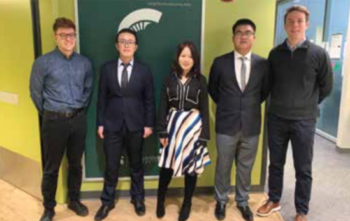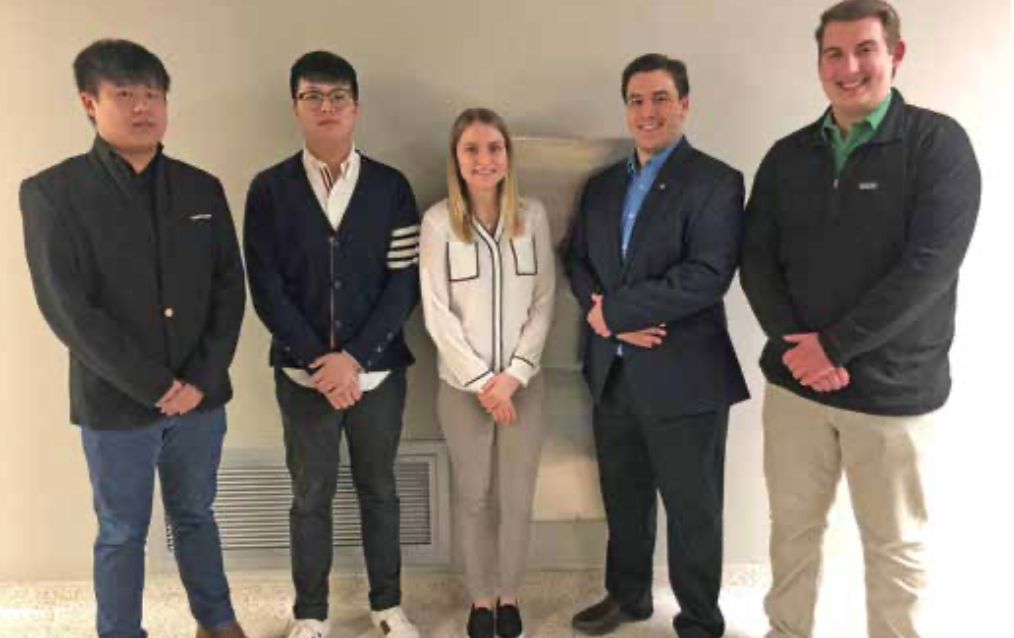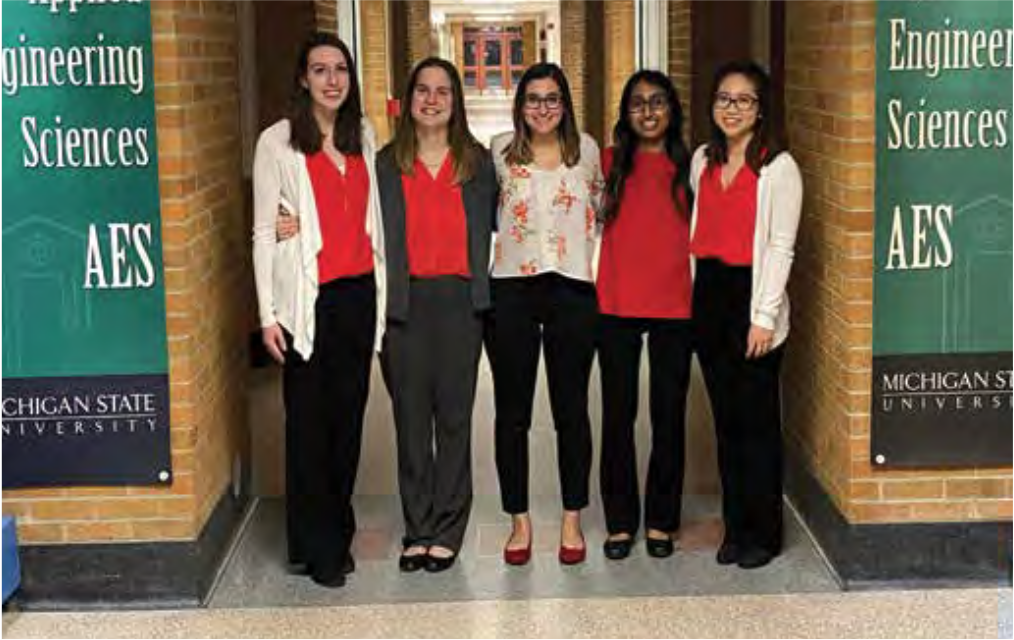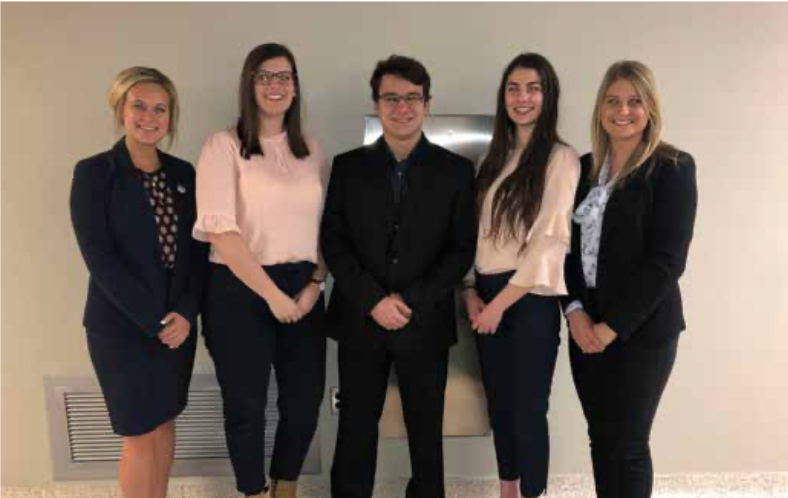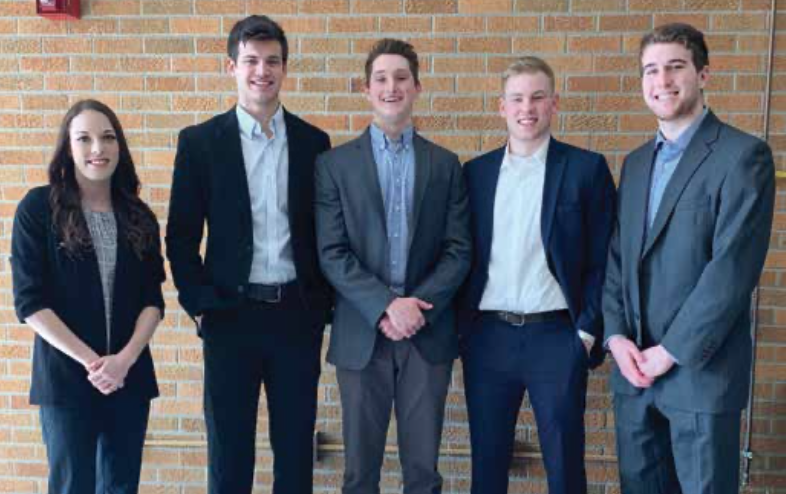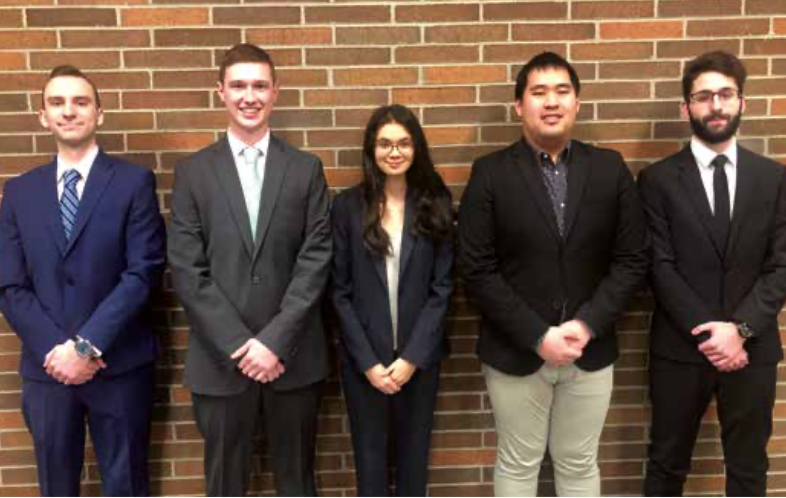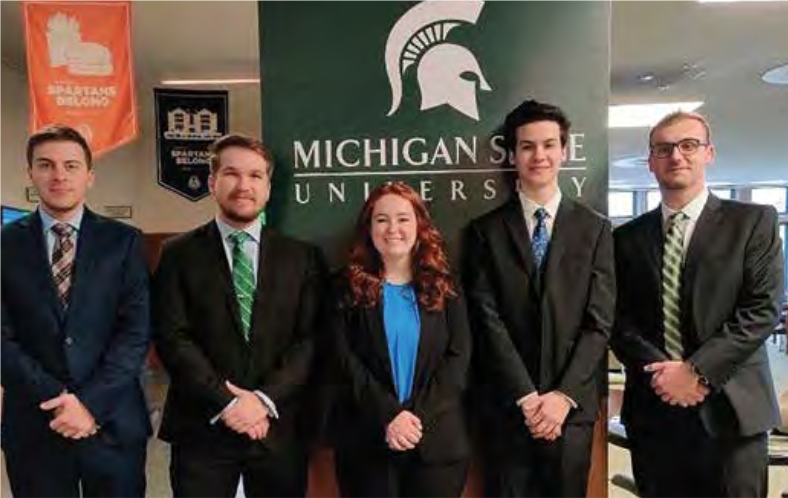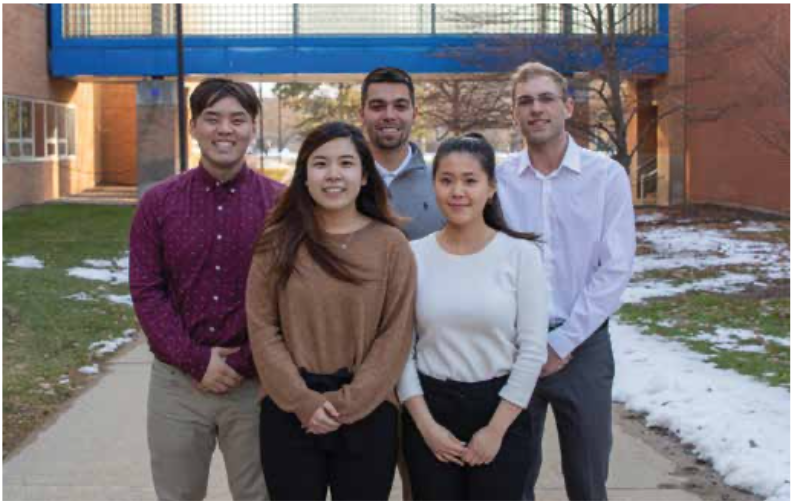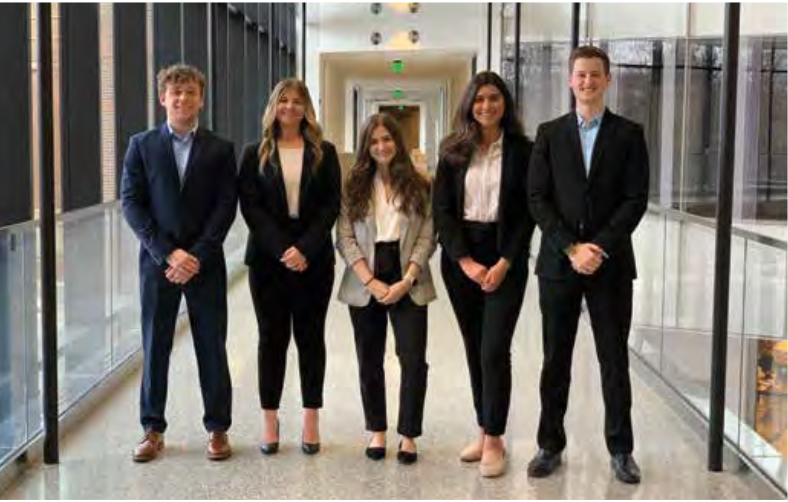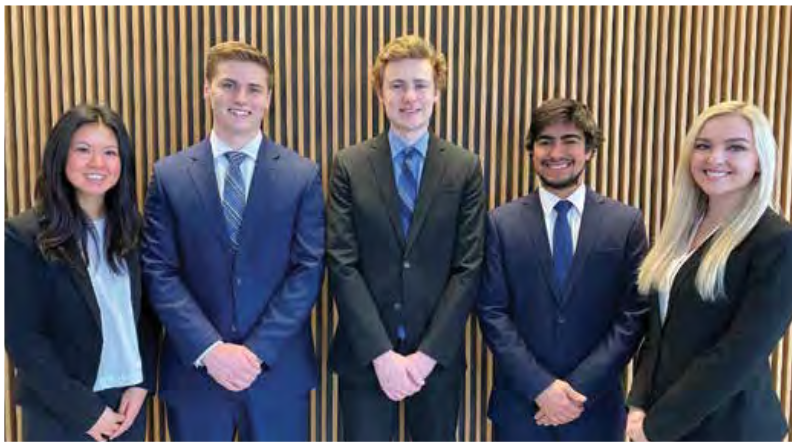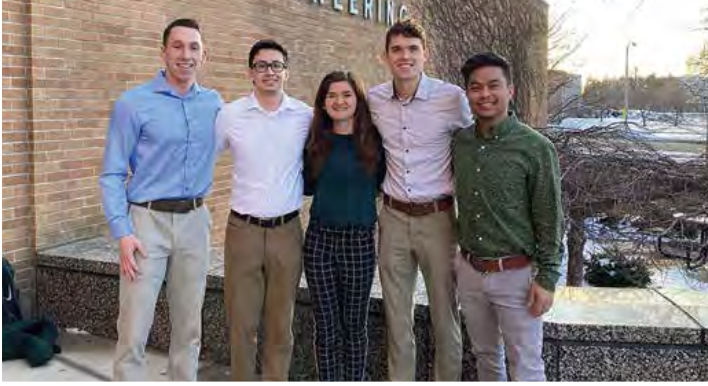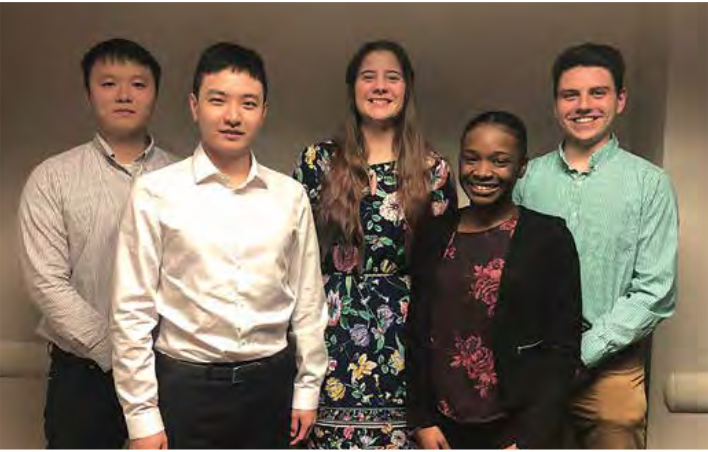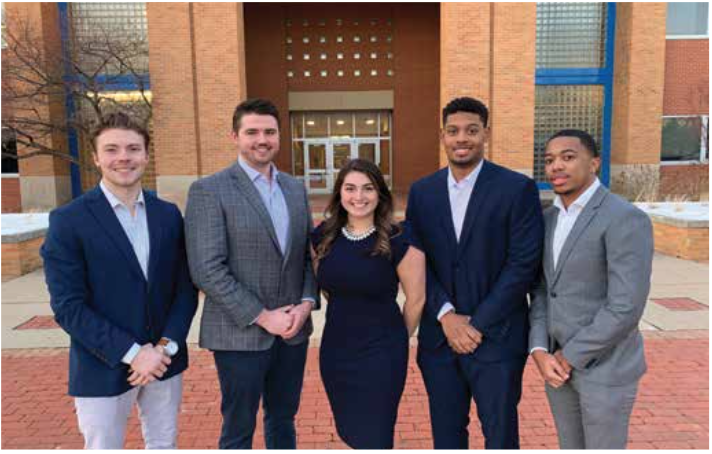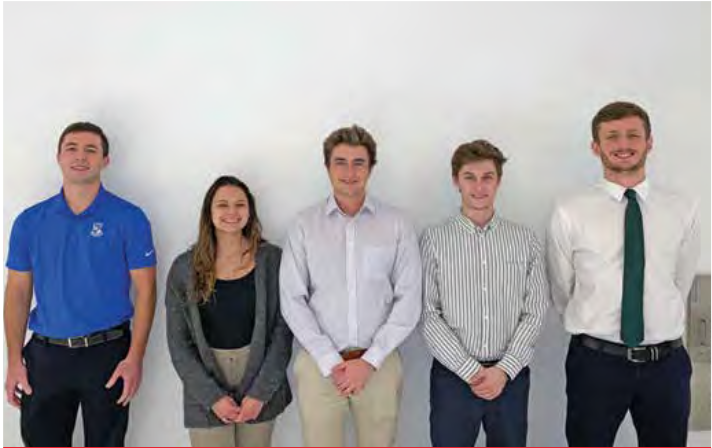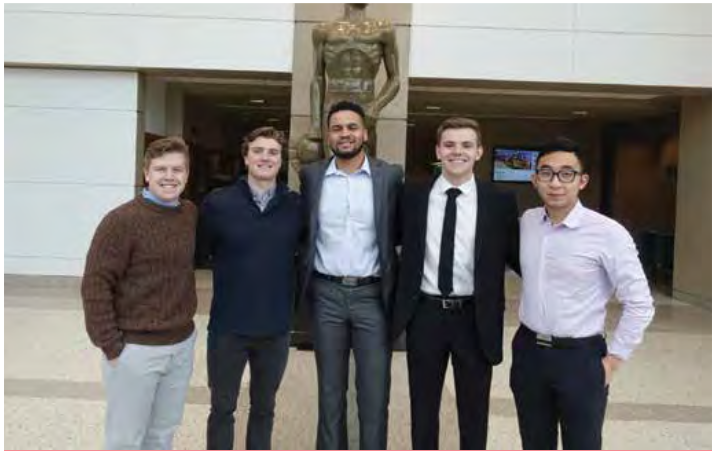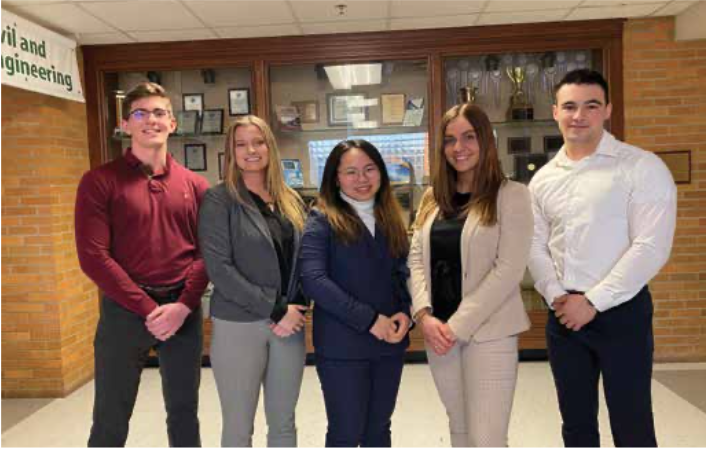For information on becoming a project sponsor, please contact Dr. Laura Genik.
Applied Engineering students participate in Spring Term Design Day. The following were the project sponsors and projects for the Spring of 2020:
Aspen Surgical: Automated Pen-Plug Placement Station Redesign
 Established in 1999, Aspen Surgical has quickly become a leader in the market of surgical disposable products. Between their two facilities in Michigan and Puerto Rico, Aspen Surgical operates with over 500 dedicated employees and 250,000 square feet of manufacturing and office space.
Established in 1999, Aspen Surgical has quickly become a leader in the market of surgical disposable products. Between their two facilities in Michigan and Puerto Rico, Aspen Surgical operates with over 500 dedicated employees and 250,000 square feet of manufacturing and office space.
Aspen Surgical manufactures and sells a wide range of products including scalpels, surgical needles, instrument cleaning equipment, and several safety accessories. One of their top product categories is the patient identification and surgical marking pens. Over 120 million pens were manufactured and sold during 2019 alone.
Several different types of patient identification and surgical marking pens are made and sold through Aspen Surgical. Unfortunately, persistent manufacturing errors can occur due to the design of the pen-plug feeding station.
Occasionally, during assembly, the design of the pen-plug feeding station can cause machinery jams, misfeeding of the plugs, or damaged components. These issues can lead to having to temporarily halt the assembly process from anywhere between seconds to hours of valuable manufacturing time depending on the issue.
Our team has worked to develop a machinery solution that provides a potential solution to be implemented within the already present assembly machinery for the marking pens. This solution could be used by Aspen Surgical to decrease the downtime of their machinery.
This potential solution could allow Aspen Surgical to grow even further within their market through the creation of more patient identification and surgical marking pens while furthering their reputation as a reputable, reliable company.
ASU/NASA Psyche Mission: Capstone Design Scalability
 NASA’s Psyche Mission is a journey to a faraway asteroid with the hope that it will be able to teach us something about our home. Psyche is an asteroid, made of metal, orbiting the Sun between Mars and Jupiter. What makes Psyche important is that it is believed to be the exposed nickel-iron core of an early planet. The goal of the mission is to launch an unmanned spacecraft to study the asteroid to find out if it is the core of an early planet and what it can tell us about the core of our own planet.
NASA’s Psyche Mission is a journey to a faraway asteroid with the hope that it will be able to teach us something about our home. Psyche is an asteroid, made of metal, orbiting the Sun between Mars and Jupiter. What makes Psyche important is that it is believed to be the exposed nickel-iron core of an early planet. The goal of the mission is to launch an unmanned spacecraft to study the asteroid to find out if it is the core of an early planet and what it can tell us about the core of our own planet.
The mission is being led by Arizona State University’s School of Earth and Space Exploration but includes over 40 capstone teams from universities all over the United States. Each capstone team has its own unique place in the mission. Our team’s goal is to locate inefficiencies in the internal processes of the team at ASU and give recommendations as to how to improve on them to ensure a more efficiently moving mission and scale the mission by adding new capstone teams from more universities across the country.
To improve the internal processes of the mission, the team had to take an in-depth look at the current processes the team at ASU had been performing. The team then had to research project management processes, tools, and software to find those that would improve the lives of the team at ASU.
The mission has a launch date in 2022. With it quickly approaching, the team is looking to scale the amount of capstone teams to include more diverse teams that come from a wide range of technical backgrounds. The team is making that possible by providing the necessary information and tools on how to reshape their internal mission processes to make this a reality.
Caterpillar: Customer Order Pattern Analysis
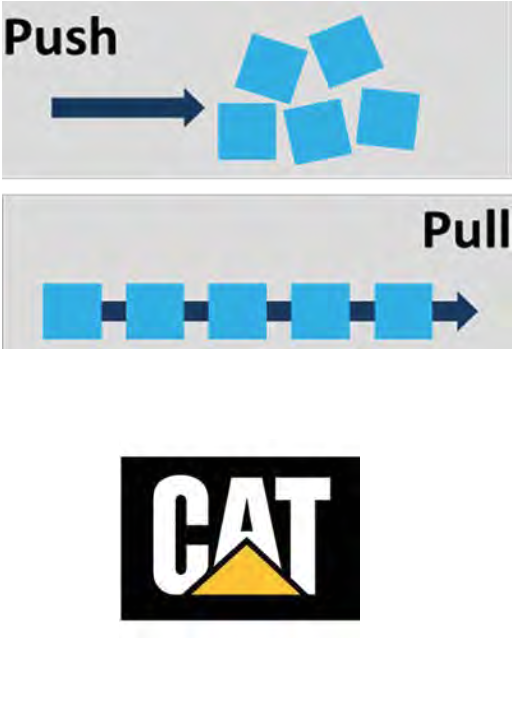 For the past several decades, Caterpillar has used a standard ordering and delivery system for parts such as seals, nuts and bolts. These parts are delivered to Caterpillar’s manufacturing facilities through its internal distribution network, the Caterpillar Manufacturing Parts Nodes (MPN) Network. There are three “nodes,” also called logistic centers, in North America that will be the focus of this project. These three nodes service over 300 customers and 30,000 unique parts.
For the past several decades, Caterpillar has used a standard ordering and delivery system for parts such as seals, nuts and bolts. These parts are delivered to Caterpillar’s manufacturing facilities through its internal distribution network, the Caterpillar Manufacturing Parts Nodes (MPN) Network. There are three “nodes,” also called logistic centers, in North America that will be the focus of this project. These three nodes service over 300 customers and 30,000 unique parts.
Due to current system limitations, each manufacturing facility can order parts from these nodes using only one of the two following methods: a 24-hour Kanban pull trigger, or a forecasted MRP push method with defined lead times and due dates. With pending system upgrades, these ordering system limitations could be removed because Caterpillar suspects there is value in allowing each customer to use both a push and pull method, depending on the part.
Our project is to determine which parts should use a push method and which parts should use a pull method; doing so has the potential to increase the velocity of the supply chain and reduce inventory-related costs for the network and its customers.
The main goal is to develop a classification model to help Caterpillar determine which parts should use the 24-hour Kanban pull trigger or use the forecasted MRP push system. The classification model will determine and quantify which ordering method(s) will be most optimal for each customer’s associated parts.
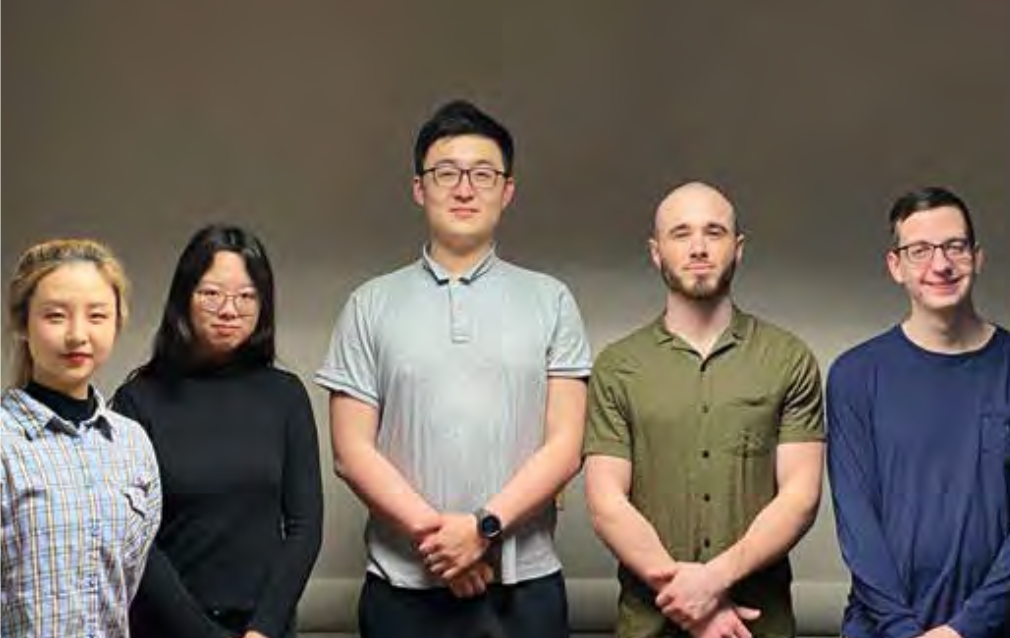
Team Members (L-R): Hongtong Ou, Jiani Li, Desheng Lu, Griffen Rourke, Alex Burger
Caterpillar: Improving the Supply Chain through Data Visibility
 Caterpillar (CAT) began in 1925 after the merger of two tractor companies. Its humble beginnings transitioned into a multi-billion-dollar construction company, continuing their tractor business and expanding into engines, construction equipment, financial services, and insurance services. The bulk of CAT’s revenue is generated from the engines and the equipment it powers, which leads to the need for inventorying and distributing a massive amount of parts.
Caterpillar (CAT) began in 1925 after the merger of two tractor companies. Its humble beginnings transitioned into a multi-billion-dollar construction company, continuing their tractor business and expanding into engines, construction equipment, financial services, and insurance services. The bulk of CAT’s revenue is generated from the engines and the equipment it powers, which leads to the need for inventorying and distributing a massive amount of parts.
Currently, CAT has twelve manufacturing parts nodes (MPN) located in countries all around the world. The two key metrics that help define node performance are On Time in Lines (OTIL) and Inventory Turnover. These metrics are organized and analyzed by management using Microsoft Excel. The most advanced analysis that this allows is color-sorting of cells and the creation of graphs. This makes it difficult to notice common trends, such as a yearly dip in performance, or an extremely slight trend.
Our team was tasked with discovering a better method of displaying CAT’s key metrics. With the power of Tableau, our team created a dashboard that displays metrics in a way that will allow for far better performance analysis. The dashboard will enable CAT to analyze OTIL at a part level, which will allow for a deeper analysis as to why various logistic centers are underperforming, as well as give insight regarding the trend between logistic centers’ business days and inventory turns. This dashboard will give CAT’s management team a dynamic tool to analyze and communicate its key metrics, which will help drive decision-making and innovation.
MSU IPF – Maintenance Services: Mobilize the Maintenance Stockroom
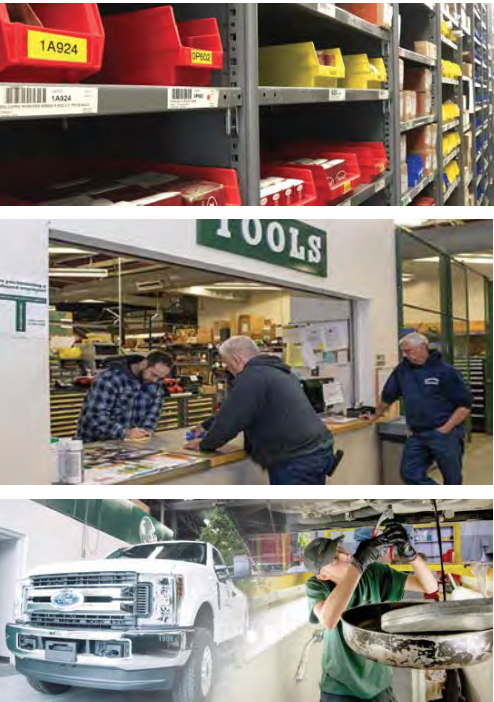 The MSU Infrastructure and Planning Facilities (IPF) Maintenance Services department is responsible for the maintenance and operations of all buildings on campus. IPF handles issues ranging from servicing dormitories to any general maintenance requests. Currently, tradesmen drive service vans around campus, carrying a limited supply of materials and tools. When a tradesman requires a certain part that is not in their vehicle, they drive to the IPF stockroom for additional materials. This can occur numerous times per day, leading to decreased productivity and increased vehicle usage by tradesmen.
The MSU Infrastructure and Planning Facilities (IPF) Maintenance Services department is responsible for the maintenance and operations of all buildings on campus. IPF handles issues ranging from servicing dormitories to any general maintenance requests. Currently, tradesmen drive service vans around campus, carrying a limited supply of materials and tools. When a tradesman requires a certain part that is not in their vehicle, they drive to the IPF stockroom for additional materials. This can occur numerous times per day, leading to decreased productivity and increased vehicle usage by tradesmen.
For this project, the plumbing tradesmen were the only team within the scope of analysis. IPF utilizes Verizon Networkfleet, a vehicle tracking software that generates reports for vehicle metrics such as: miles per gallon, vehicle emissions, length of trips, etc. Monthly reports were generated for 2019 and 2020 to analyze the following: average trip time, average miles driven, and mpg. Included in the multi-factor analysis were the labor rates of the plumbing tradesmen and other vehicle costs provided by IPF. The recommendation is to implement a student delivery model, where a student will deliver materials to multiple tradesmen when they request additional materials. IPF already has a mobile application with the capacity to implement the recommendation. The application has the capability for tradesmen to place orders from their mobile phone, and workers in the warehouse will receive a notification to pick, package, and deliver the requested materials to the tradesmen. The biggest success of this project will be eliminating the need for tradesmen to travel from their work site to the IPF stockroom to collect additional materials. In turn, there will be an increase in tradesmen productivity and a decrease in vehicle usage by the entire fleet of tradesmen vehicles, leading to less non-value add trips, fuel consumption, and emissions.
MSU IPF – Carbon Sequestration &
Carrying Capacity of MSU Trees
 ichigan State University Infrastructure Planning and Facilities Sustainability department is responsible for analyzing how MSU contributes to global climate and carbon systems. As a land grant institution, MSU has a longstanding commitment to the environment. This is evident in the many green spaces and wooded areas on campus. Currently, MSU has over 20,000 trees on campus and cuts down, on average, 300 trees per year. MSU would like to collect data and design a system that will allow them to not only understand but also manage the carbon sequestration capacity of campus.
ichigan State University Infrastructure Planning and Facilities Sustainability department is responsible for analyzing how MSU contributes to global climate and carbon systems. As a land grant institution, MSU has a longstanding commitment to the environment. This is evident in the many green spaces and wooded areas on campus. Currently, MSU has over 20,000 trees on campus and cuts down, on average, 300 trees per year. MSU would like to collect data and design a system that will allow them to not only understand but also manage the carbon sequestration capacity of campus.
This project is focused on calculating the carbon sequestration value of Michigan State’s campus in order to have a better understanding of how MSU is contributing to the local and global environment. This includes a method for calculating carbon sequestration that allows IPF to easily calculate an updated value on a yearly basis. The team is also responsible for identifying the canopy coverage of campus and mapping areas of campus where trees can be planted. This will aid IPF in the future with their plans for tree planting on campus. The project also includes creating a process to score trees based on age, canopy cover, carbon sequestration, and DBH. This score helps IPF determine which trees are most valuable to them and helps them maintain the diversity of trees on campus. Upon completion of this project, IPF will have a method of calculating the carbon sequestration value of campus, a better understanding of where to plant trees in the future, and which trees are most important to them. All of these will aid IPF in maintaining the beauty of Michigan State’s campus for years to come.
General Motors: Sequencing Strategy – Best Practice & Future Trends
 General Motors (GM), founded in 1908, has been pushing the limits of transportation and technology for over 100 years. Headquartered in Detroit, Michigan this multinational corporation designs, manufactures, markets, and distributes vehicles and vehicle parts. General Motors has transformed how the world moved throughout the last century and are determined to do it again as they redefine mobility to serve their customers.
General Motors (GM), founded in 1908, has been pushing the limits of transportation and technology for over 100 years. Headquartered in Detroit, Michigan this multinational corporation designs, manufactures, markets, and distributes vehicles and vehicle parts. General Motors has transformed how the world moved throughout the last century and are determined to do it again as they redefine mobility to serve their customers.
Our team was tasked to develop an analytical template that can be used by General Motors Supply Chain to determine the optimal build vehicle sequence strategy. Our team will work to determine the longest time that a vehicle sequence can be transmitted such that a supplier can be located and still supply the assembly plant parts in build order sequence. Within the automotive OEM industry, there is a general alignment in transmitting material requirement forecast and daily ship schedules, but there are a variety of strategies in the broadcasting of the individual vehicle build sequence.
Our team is working with General Motors to investigate whether a longer broadcast window is the optimal solution and, if so, how GM can communicate further upstream trigger points. The team is responsible for identifying potential benefits and cost savings, as well calculating the total lead time of the in-line sequencing strategy. Such findings will potentially enable a more effective supply chain strategy for each individual assembly plant and its associated vehicle launches.

Team Members (L-R): Victoria Davis, Meghan Zula, Megan Klimkowski, Gabriele Manley, Alyssa Sekulovski
Guardian Industries: Float Glass Rack Optimization
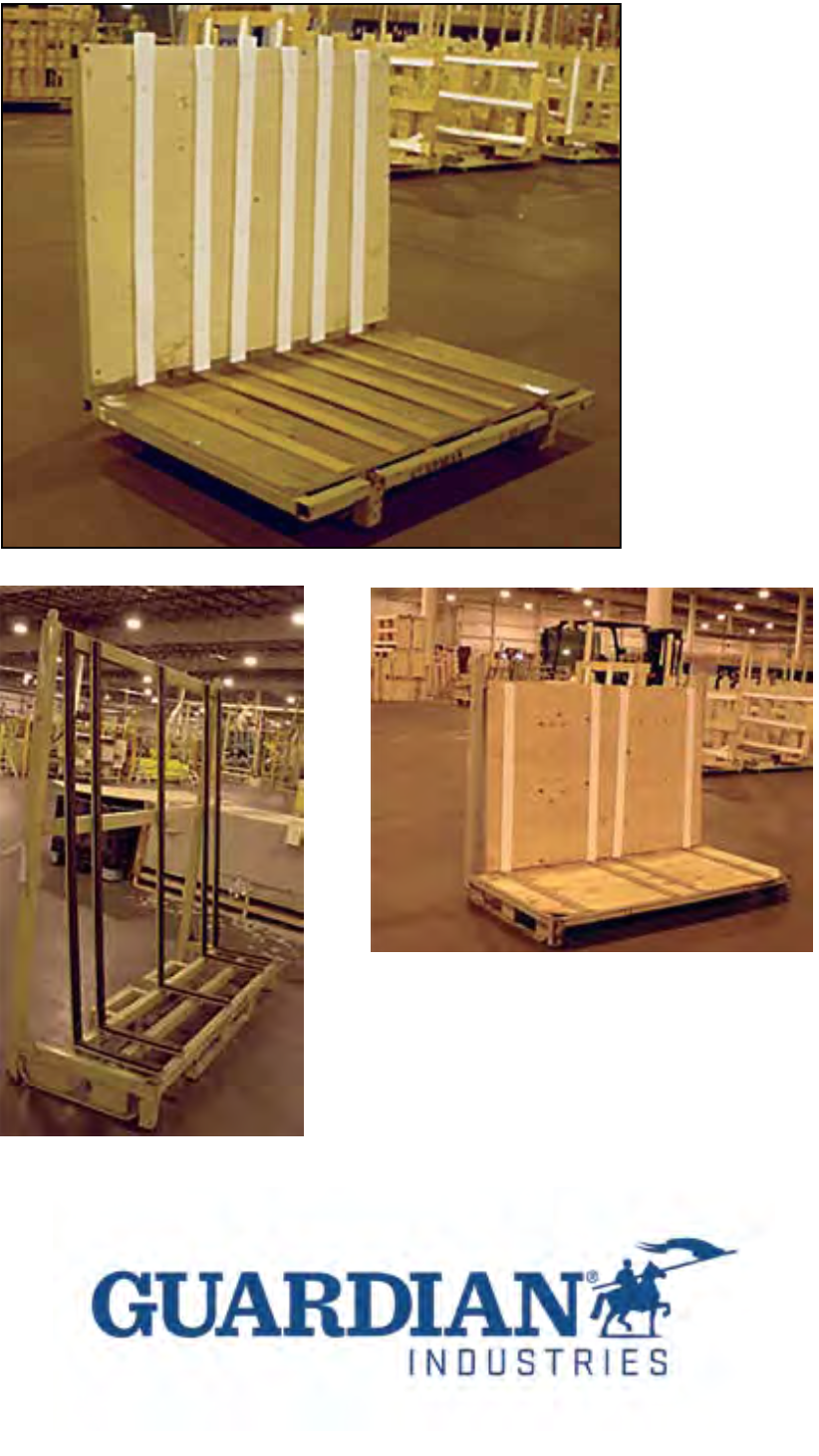 Guardian Industries is a privately held industrial manufacturer of glass primarily for building applications. The company is one of the world’s largest glass manufacturers, serving about 160 countries and five continents with headquarters based in Auburn Hills, Michigan. The focus of this project revolves around float glass and the racks used at six of their U.S. manufacturing sites.
Guardian Industries is a privately held industrial manufacturer of glass primarily for building applications. The company is one of the world’s largest glass manufacturers, serving about 160 countries and five continents with headquarters based in Auburn Hills, Michigan. The focus of this project revolves around float glass and the racks used at six of their U.S. manufacturing sites.
Guardian Industries wished to reduce the amount of rack types that their six float glass plants were using. The objective was to analyze data on the 50 different racks in order to standardize them with a goal of keeping 10-15 racks. To do so, we analyzed the data provided, including usage in shipments since 2017, and cost data associated with each rack.
Upon initial usage analysis, it was clear that the plants had already been using approximately eight different rack types for about 97.5% of all shipments since 2017. With further discussion, we were able to refine the scope down to identifying three primary racks for Guardian to continue using. We were then encouraged to expand the scope further into more creative concepts for optimization. This included developing modifications to the design of the three existing racks to improve efficiency and allow for more glass dimension adaptability. We also expanded the project to consider the materials used for rack preparation and reduce the process time to package a rack for shipment.
Ultimately, our team was able to reduce the amount of rack types used from fifty down to three, as well as provide recommendations for future rack modifications and process improvements.
Harman: Global Supply Chain – Global Procure-to-Pay Process
 arman is a global company that touches over 30+ countries with technologies that create a connected world. Harman is involved in various technologies: connected car, lifestyle audio, professional solutions, and connect services. Harman is the industry standard in studios and on the stage for various artists. They have worked in venues around the world and maintain long- term customers like Audi, BMW, and Volkswagen.
arman is a global company that touches over 30+ countries with technologies that create a connected world. Harman is involved in various technologies: connected car, lifestyle audio, professional solutions, and connect services. Harman is the industry standard in studios and on the stage for various artists. They have worked in venues around the world and maintain long- term customers like Audi, BMW, and Volkswagen.
With multiple, diverse products comes a lot of movement and shipping of their products.
Harman currently does not have a unified procure-to-pay freight audit process among the different regions of the company. Harman is striving to understand all processes: North America, Europe and Asia. Harman is motivated to understand what needs to change within their current regional processes.
The focus of the project will be to develop a process map of Harman’s current process in each region, specifically targeting freight audit information. This process map will act as an internal guide for Harman.
Harman has asked our team to highlight gaps in the process. Therefore, our team will be performing an analysis of each region’s process, which will allow us to identify inconsistencies between processes across different regions of the world.
The findings will be presented in an online packet for Harman. This resource will enable Harman to demonstrate inconsistencies between processes and implement a unified solution. These findings will provide Harman with crucial feedback on how to improve their freight audit process for different regions within North America and the globe.
ASU / NASA Psyche Mission: Visualizing Contributions to Successful Space Mission
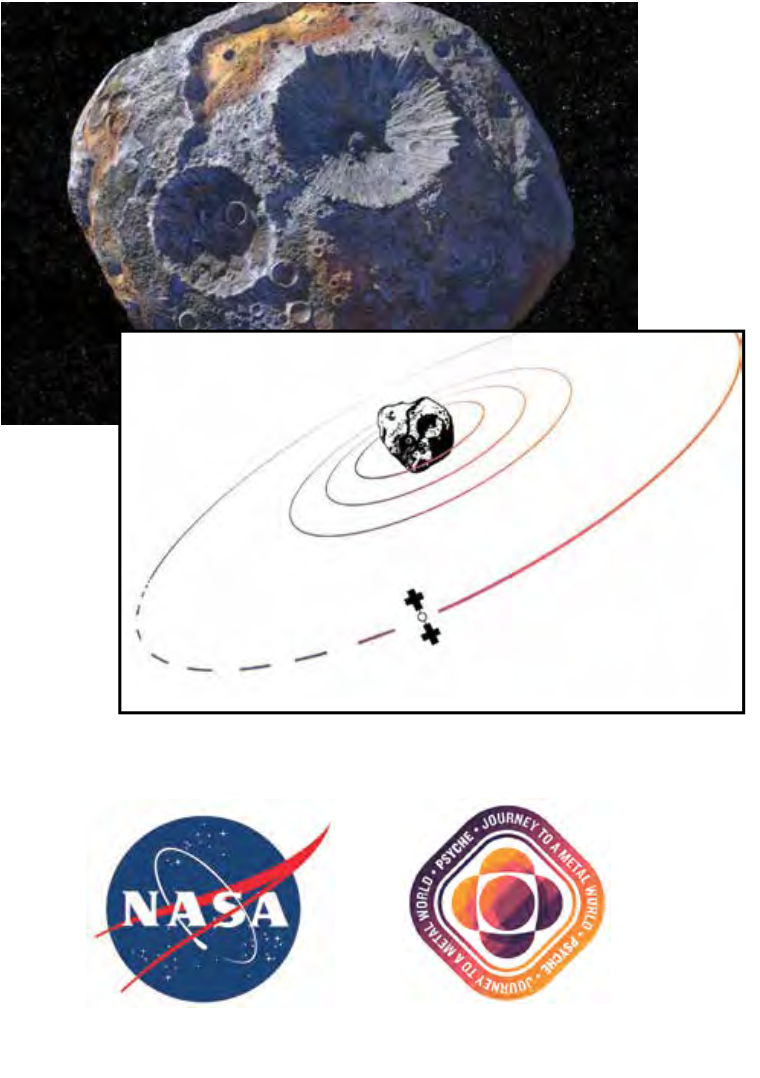 NASA has made the journey and exploration outside of Earth possible. Whether it is a trip to the moon, other planets in our solar system, or an asteroid made of metal, NASA is working to explore it all. The NASA Psyche Mission is an exploration, led by Arizona State University, to an asteroid not made of rock or ice, but almost entirely of metal. The belief is that this nickel-iron asteroid is the remnant of an early planet that lost its outer shell over the course of many violent collisions. Earth’s planet core is too hot and deep to realistically explore. Psyche provides the opportunity to explore a planet core and lead to discoveries about how Earth and other planets came to form.
NASA has made the journey and exploration outside of Earth possible. Whether it is a trip to the moon, other planets in our solar system, or an asteroid made of metal, NASA is working to explore it all. The NASA Psyche Mission is an exploration, led by Arizona State University, to an asteroid not made of rock or ice, but almost entirely of metal. The belief is that this nickel-iron asteroid is the remnant of an early planet that lost its outer shell over the course of many violent collisions. Earth’s planet core is too hot and deep to realistically explore. Psyche provides the opportunity to explore a planet core and lead to discoveries about how Earth and other planets came to form.
Our team was tasked to create an interactive visualization that showcases the complexity of the Psyche Mission. The Psyche team is not just a team of engineers but requires the involvement of many people that each bring a different expertise to the table. In the project, each team member became an expert on specific categories that make the mission possible. The key components our team decided to focus on include the background and timeline of the mission, the Psyche asteroid itself, partnered institutions and team members, and key spacecraft components and suppliers. The visualization brings together each category and the complexity of launching a mission like this one.
Our team has worked diligently for the past few months to ensure the best design of said visualization in order to make information regarding the Psyche Mission accessible and understandable to the public. The four main categories we focused on are vital to pushing Psyche to the front of the race in terms of being a well-known mission. It is important that public awareness and involvement in the mission is high, so the public is aware of how their tax dollars being used.
MSU Resource Center for Persons with Disabilities: Gotcha – Electric Scooter Revolution
 MSU Resource Center for Persons with Disabilities (RCPD) delivers equal access to university education for all students. The Center provides services to students and employees who are blind/visually impaired, deaf/hard of hearing, have barriers with mobility, learning disabilities, brain injuries, psychiatric, and various chronic health conditions.
MSU Resource Center for Persons with Disabilities (RCPD) delivers equal access to university education for all students. The Center provides services to students and employees who are blind/visually impaired, deaf/hard of hearing, have barriers with mobility, learning disabilities, brain injuries, psychiatric, and various chronic health conditions.
Michigan State University is committed to providing equal opportunity for full participation in all programs, services and activities. The exponential use of electric scooters on MSU’s campus and nationally has led to challenges upholding this commitment. When parked in the middle of sidewalks and walkways, scooters create significant physical risks, particularly for persons with visual impairments This project identified and pursued solutions to reduce safety concerns for these individuals. Michigan State University has established a cooperative partnership with Gotcha who are interested in developing solutions for national implementation. Our team collaborated with Gotcha throughout the project to ensure the solution’s effectiveness.
The project involved the sponsor, MSU RCPD, and MSU’s contractual relationship with Gotcha. The goal was to create a mobile application on the iOS platform to aid those with visual impairments in detecting incorrectly parked Gotcha scooters. This app uses Bluetooth scanning to pinpoint the locations of nearby Gotcha scooters and alert the user once within a given proximity. This feature can be toggled on and off to preserve confidentiality and when not required. When the feature is toggled on, Gotcha scooters will emit an auditory alert once close enough to the device. This alerts the user of the upcoming obstruction as well as its location to reduce the risk of potential bodily injury. This application also provided Gotcha with a proof-of-concept for implementing a similar functionality within their existing app.
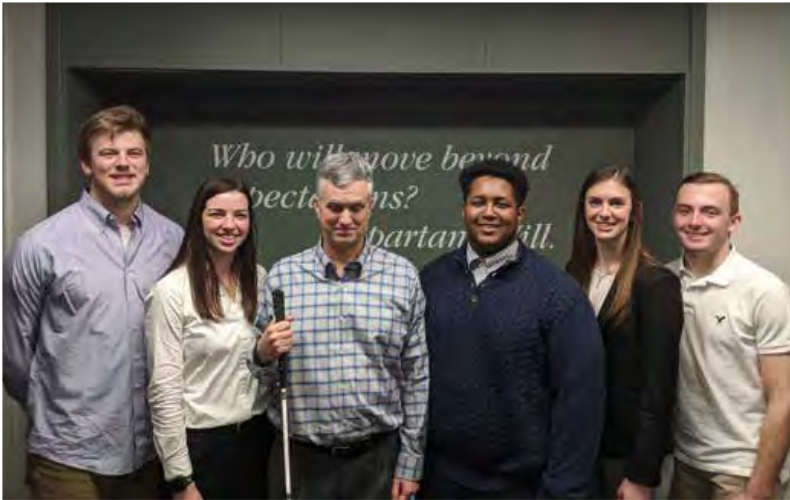
Team Members (L-R): Nate Olsen, Bailee Droste, Mike Hudson (Sponsor), Mamduh Muridi, Sophia Venticinque, AJ Shaw
MSU IPF – Custodial Services: Robotics Workforce Analysis
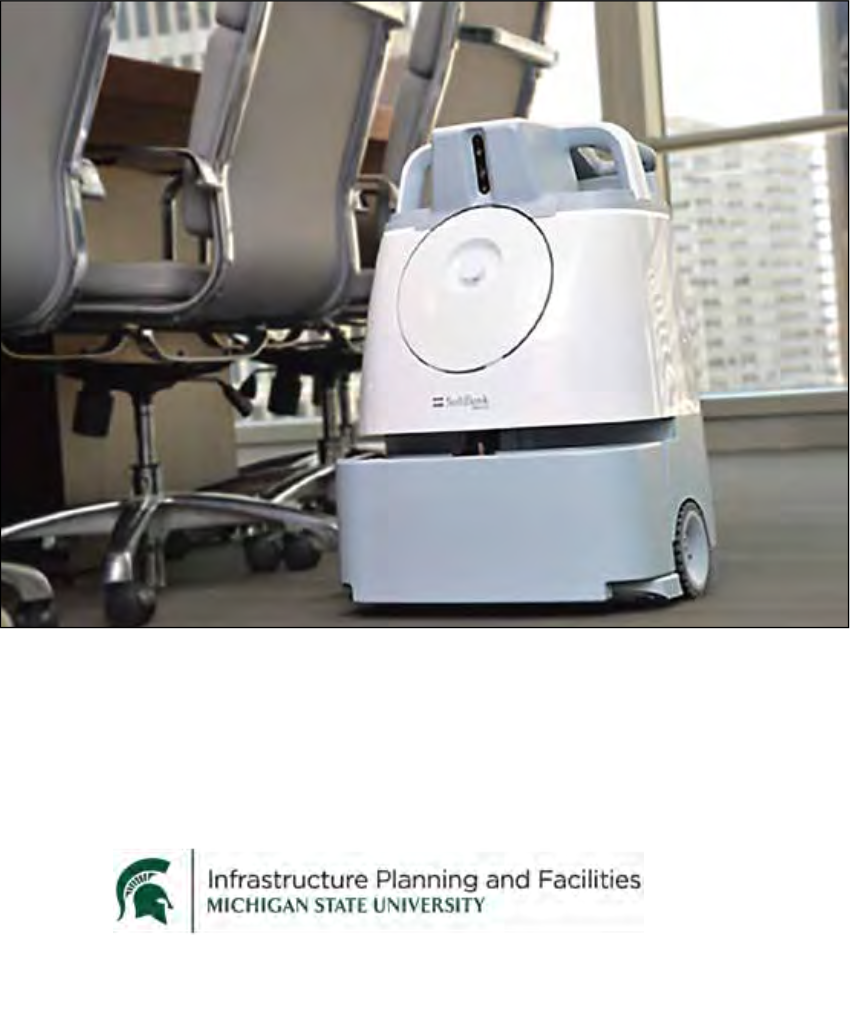 MSU IPF Custodial Services hires over 330 employees to clean over 13.5 million gross square feet of campus facilities. High turnover rate is a current challenge, such as the 200% rate of temporary positions in 2018. In order to combat this challenge, semi- autonomous floor cleaning robots have been purchased and deployed so that employees can be allocated to other cleaning tasks. This project will work towards creating an understanding for how the fleet of robots can be employed to improve efficiency from a man hours and financial perspective. By continuing to pursue an interest in robotics, this provides an opportunity to enhance the custodial workforce through increased performance and provide new ways for custodial employees to align with strategic planning initiatives.
MSU IPF Custodial Services hires over 330 employees to clean over 13.5 million gross square feet of campus facilities. High turnover rate is a current challenge, such as the 200% rate of temporary positions in 2018. In order to combat this challenge, semi- autonomous floor cleaning robots have been purchased and deployed so that employees can be allocated to other cleaning tasks. This project will work towards creating an understanding for how the fleet of robots can be employed to improve efficiency from a man hours and financial perspective. By continuing to pursue an interest in robotics, this provides an opportunity to enhance the custodial workforce through increased performance and provide new ways for custodial employees to align with strategic planning initiatives.
The goal of the project is to deliver the requested current state analysis with documentation and information gathered throughout the investigative process specifically looking into finances, operations, and efficiency reports. A PowerPoint presentation of the project will be used in future conferences to share MSU Custodial Services’ pioneering research in the application of robotics to custodial services. The current state analysis will provide the framework to assist with the current and future integration of robotics into the custodial workforce at MSU and will show MSU’s commitment to maintaining its cutting-edge status with technology integration into custodial work.
John Deere: Engine Overhaul Kit Packaging Study
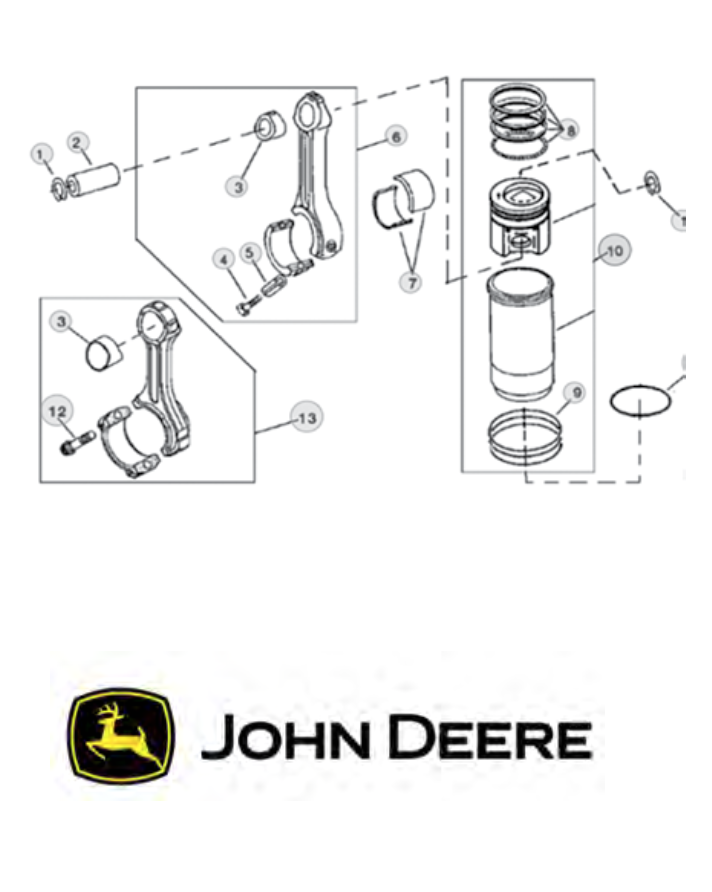 The objective of this project is to create a business case and to evaluate the feasibility of removing Piston Liner Kits (PLK), as seen in the schematic to the right, from the larger Engine Overhaul Kits (EOK). This is done to reduce the cost of shipping the EOKs, as well as to reduce the amount of damage claims upon arrival, which lead to increased costs due to expedited shipping. Removing the PLKs will generate expected cost savings due to a reduced risk of damage to all EOK components and due to a weight reduction of the EOK. This will be done by analyzing logistics costs, cost of expedited shipping using the current system, estimated cost of expedited shipping with new packaging, and cost of standard shipping, as well as estimated shipping with reduced weight.
The objective of this project is to create a business case and to evaluate the feasibility of removing Piston Liner Kits (PLK), as seen in the schematic to the right, from the larger Engine Overhaul Kits (EOK). This is done to reduce the cost of shipping the EOKs, as well as to reduce the amount of damage claims upon arrival, which lead to increased costs due to expedited shipping. Removing the PLKs will generate expected cost savings due to a reduced risk of damage to all EOK components and due to a weight reduction of the EOK. This will be done by analyzing logistics costs, cost of expedited shipping using the current system, estimated cost of expedited shipping with new packaging, and cost of standard shipping, as well as estimated shipping with reduced weight.
To create a business case for John Deere, competitors were benchmarked in order to understand the industry standard and how these kits are normally packaged. This illuminates areas where John Deere can possibly improve on their processes.
Coordinating with John Deere’s packaging supplier to develop new dimensions for packaging the EOKs and PLKs to be shipped separately has also been done.
Our team performed this analysis to find profit potential with the new shipping arrangement as well as to help reduce potential damage from occurring during shipping.
In the end, the team will have shown if there is a business case to remove the Piston Liner Kit from the Engine Overhaul Kit, which John Deere can use in the future.
John Deere: Part Consolidation and Proliferation Avoidance
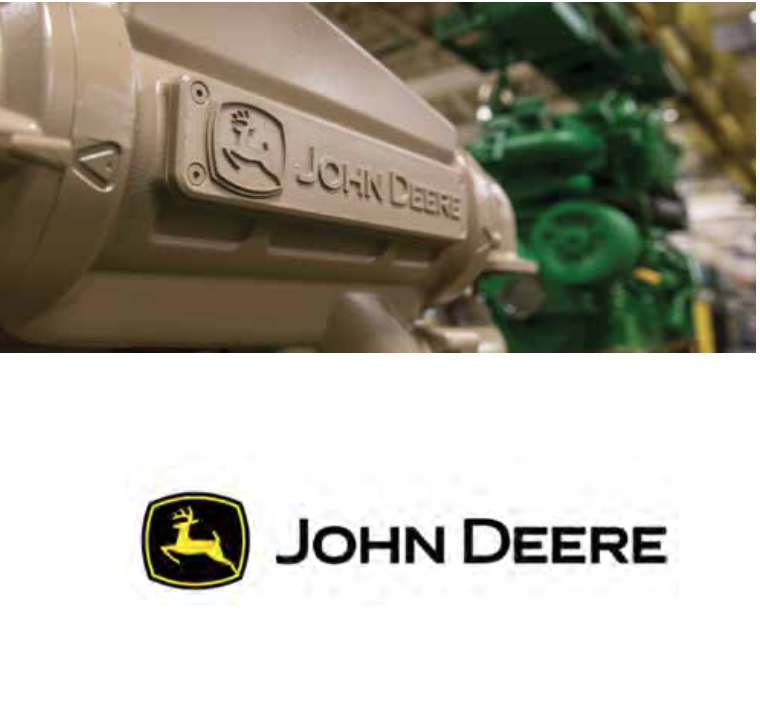 ohn Deere is a world leader providing advanced products and services and is committed to those linked to the land. Since it was founded in 1873, John Deere has been delivering innovative
ohn Deere is a world leader providing advanced products and services and is committed to those linked to the land. Since it was founded in 1873, John Deere has been delivering innovative
products built with the utmost quality and rooted in the tradition of integrity. The company, headquartered in Moline, Illinois, currently sells machines and engines for a variety of applications such as agricultural equipment, construction, marine, and forestry. Our team is specifically working with a division of John Deere called John Deere Power Systems, which manufactures agricultural, industrial, marine, and genset diesel engines.
John Deere Power Systems has tasked our team with tackling its historic part proliferation within its turbocharger platform. Turbochargers extract energy from the exhaust of an engine and use the energy to compress air entering the engine. John Deere would like to reduce the amount of turbocharger complexity that exists across its engine product lines. Reducing the proliferation of turbochargers will allow the company to have a better understanding of overall part- carrying cost and an easier path in product serviceability. This will lead to significant reductions in part procurement cost and complexity while improving quality.
Our team’s effort is divided into three components: research, part analysis, and economic analysis. Our first task is to help build the business case for Deere to work towards reducing turbocharger part proliferation. This includes research into how reducing proliferation in industry has been successful. Once the best approach has been established, we will categorize and group turbocharger designs from their attributes to identify part numbers that are duplicates or could be substituted. Lastly, an economic analysis will reveal the opportunistic reduction in cost, quality issues, and complexity from implementation of this grouping and duplicate reduction scheme.
John Deere: Strategy Refresh – Wireform
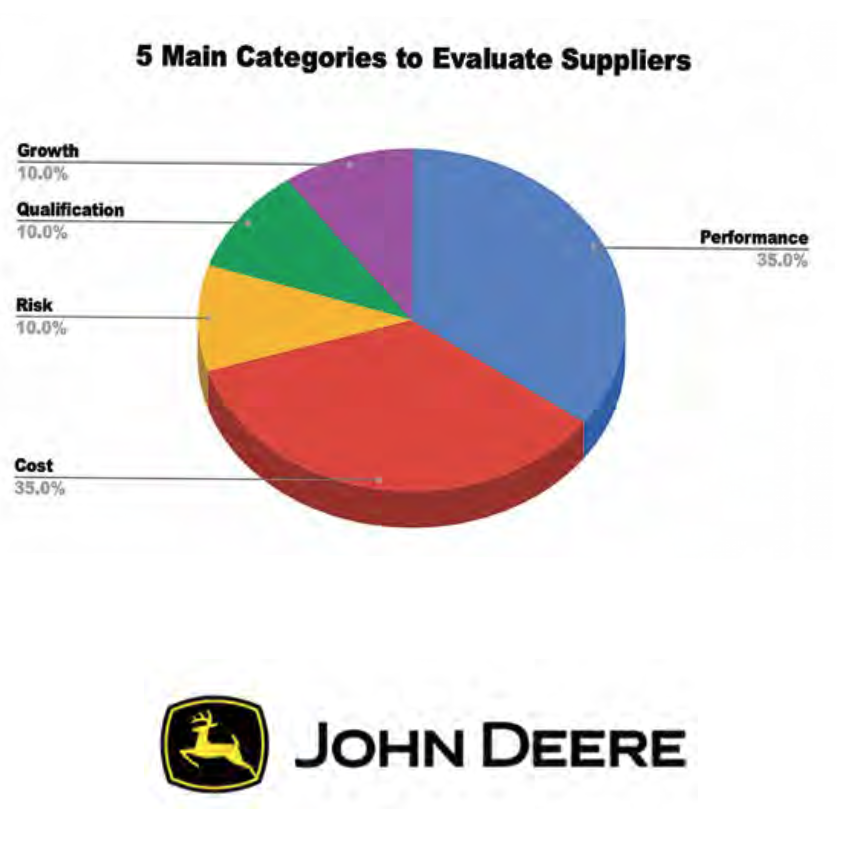 John Deere, a manufacturing company headquartered in Moline, Illinois, is known for agricultural, construction, forestry machinery, diesel engines, drivetrains used in
John Deere, a manufacturing company headquartered in Moline, Illinois, is known for agricultural, construction, forestry machinery, diesel engines, drivetrains used in
equipment, and lawn care equipment.
Our team developed a supplier evaluation tool for John
Deere to quantitatively assess suppliers that can be beta-tested on the company’s current suppliers within their wireform commodity. The tool calculates average supplier scores based on five evaluation categories (performance, cost, risk, growth, and qualifications) that are weighted according to John Deere’s supplier priorities. The categories are made up of various sub- criteria that include examples of quality, delivery, supplier certifications, financial stability, and capacity.
Documenting the key supplier metrics creates an up-to- date supplier scoreboard and gives a high-level overview of the suppliers and commodity base as a resource for strategic decision- making. Additionally, the tool provides an opportunity for John Deere to understand the current state and standing of suppliers among other suppliers. Our objective is to form a quantifiable feedback tool for supply base managers and prioritize supplier evaluation categories for varying metrics within the tool. The long-term objective is to establish an integratable and functioning supplier evaluation tool that can be implemented across all John Deere commodities.
Truck-Lite Co, LLC: Supplier Performance Scorecard
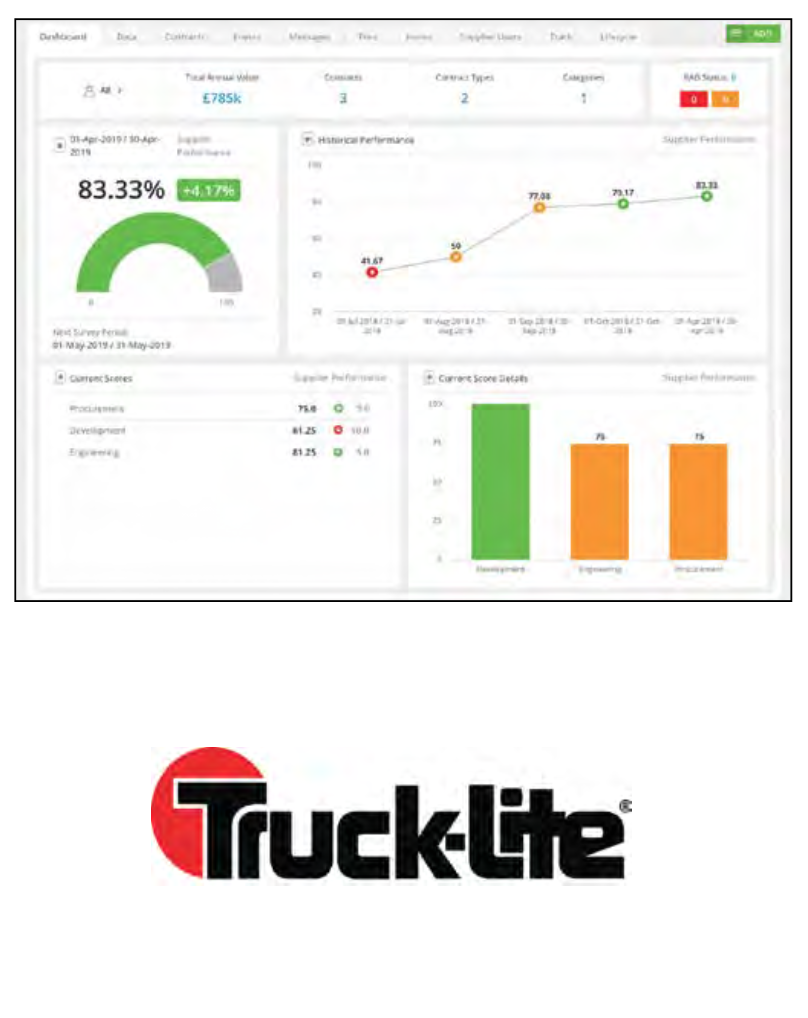 Founded in 1955, Truck-Lite is a premier vehicle electronics company with an international presence that provides lighting, safety, engine filtration and telematic products into the commercial vehicle, military, recreational and marine industries.
Founded in 1955, Truck-Lite is a premier vehicle electronics company with an international presence that provides lighting, safety, engine filtration and telematic products into the commercial vehicle, military, recreational and marine industries.
Our project is to develop a Supplier Performance Scorecard that will be common across Truck-Lite’s five divisions: Truck-Lite, Rigid, Lumitec, Davco, and RoadReady. This scorecard will incorporate consistent performance data across the previously mentioned divisions. With approximately 1,000 suppliers, it is critical to set clear performance expectations and measure key performance indicators (KPIs).
The scorecard will include, but will not be limited to, measuring performance as it relates to cost, quality, delivery, and innovation. We will benchmark industry scorecards by utilizing academic knowledge and previous professional experiences, while gaining an understanding of what is important to Truck-Lite’s functional leaders and internal stakeholders.
Implementation of the team’s recommendation aims to have a significantly positive impact for supplier performance, which will become the basis for choosing the suppliers that remain in Truck-Lite’s supply base.
KLA: Manufacturing Cost Modeling by Product Type & Region
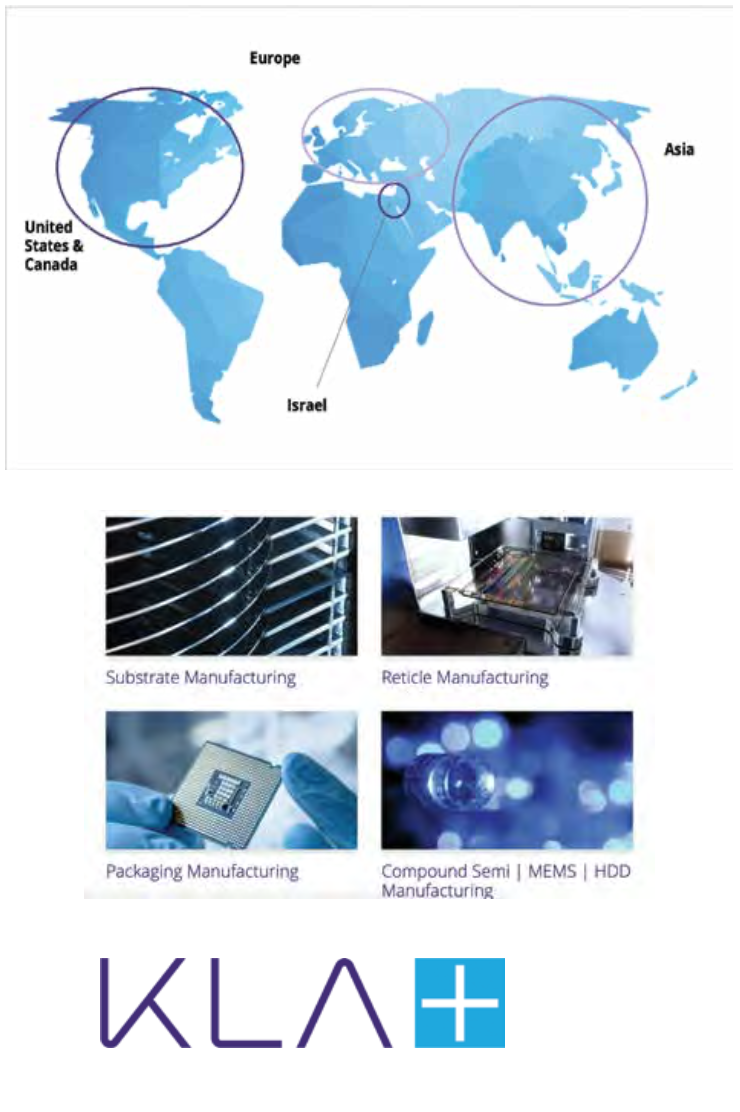 Keep Looking Ahead Corporation (commonly known as KLA) was founded in 1997 with the merger of two large semiconductor equipment companies, KLA Instruments and Tencor Instruments. Based in Milpitas, California, KLA is a worldwide leader in creating technological solutions for the next generation. They specialize in electric and photon optics, sensor technology, and artificial intelligence.
Keep Looking Ahead Corporation (commonly known as KLA) was founded in 1997 with the merger of two large semiconductor equipment companies, KLA Instruments and Tencor Instruments. Based in Milpitas, California, KLA is a worldwide leader in creating technological solutions for the next generation. They specialize in electric and photon optics, sensor technology, and artificial intelligence.
As KLA is looking ahead to expand the company worldwide, it is important to determine where the best locations to expand would be. To accomplish this, KLA asked our team to create a visual representation of manufacturing cost by region. These regions would include North America, Europe, Asia, and any other countries we find significant while conducting research. The costs associated with manufacturing include land and property cost, labor cost, as well as the cost of specialization in these industries. Specialization consists of finding individuals who are highly qualified in optics, optical engineering, and physics from reputable educational institutes around the world.
Our team, consisting of Supply Chain Management and Applied Engineering Sciences students, chose Tableau as the software to create a heat map of the associated costs and the regions of specialization data. The purpose of the heat map is to calculate and show KLA the cost and availability of land and labor, as well as the countries that specialize in the field. By building the database in Excel and utilizing functions within the program, KLA can determine and change how much each cost factor should weigh when calculating manufacturing cost. This heat map acts as a cost tool and will give KLA the information they need to determine where the next location to expand should be.
KLA: IP Risk Analysis by Product Type & Region
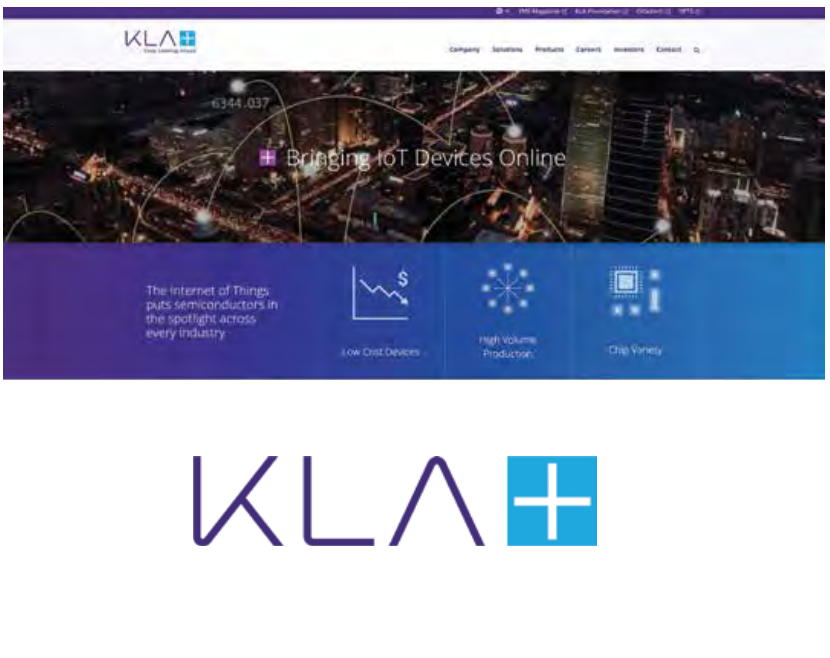 KLA is a leading global equipment company that supplies process control equipment to the semiconductor industry. Due to KLA’s massive investments in R&D that increase year after year, intellectual property protection is of the utmost importance to them.
KLA is a leading global equipment company that supplies process control equipment to the semiconductor industry. Due to KLA’s massive investments in R&D that increase year after year, intellectual property protection is of the utmost importance to them.
Our project is to deliver a unique heat map to KLA, mapping the intellectual property risk of different regions throughout the world. KLA will be able to confidently see which countries are best at protecting intellectual property. The regions being looked at are Asia, Europe, and North America and others. In Asia, the individual countries being examined are China, Japan, Taiwan, South Korea, Vietnam, Thailand, and Malaysia. In Europe, Germany, Czech Republic and Romania are being studied. Lastly, in North America and others, the United States and Israel are analyzed.
To accurately evaluate intellectual property risk, our team utilizes MSU resources such as past studies, alumni research, and formal definitions. The main basis of concern in each region is the intellectual property protection laws, agencies, regulations, and enforcement. Additionally, the frequency of intellectual property is also important. To ensure that this heat map is unique to KLA, an emphasis on each KLA product (Optics, Lasers, and Image Computers) is weighed into each regions’ rankings. KLA’s investment history and product revenue are the key characteristics that define the difference and uniqueness of our heat map.
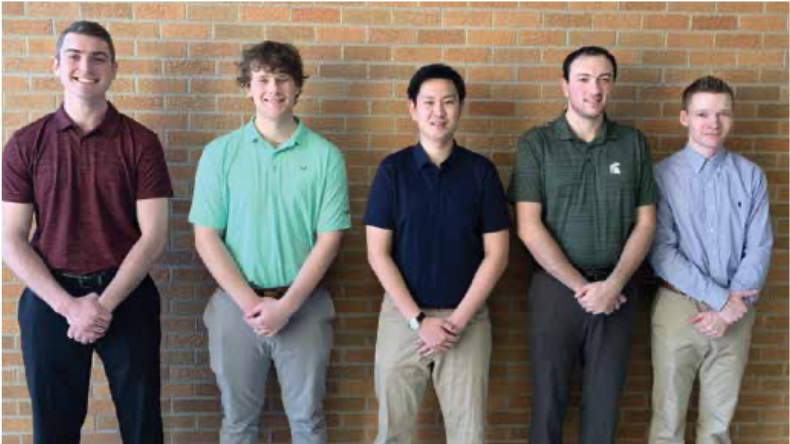
Team Members (L-R): Brendan Crites, Nathan Garlick, Timothy Chao, Jacob Gottlieb, Steven DeSantis
Quality Dairy Company: Data Driven Customer Attraction & Retention
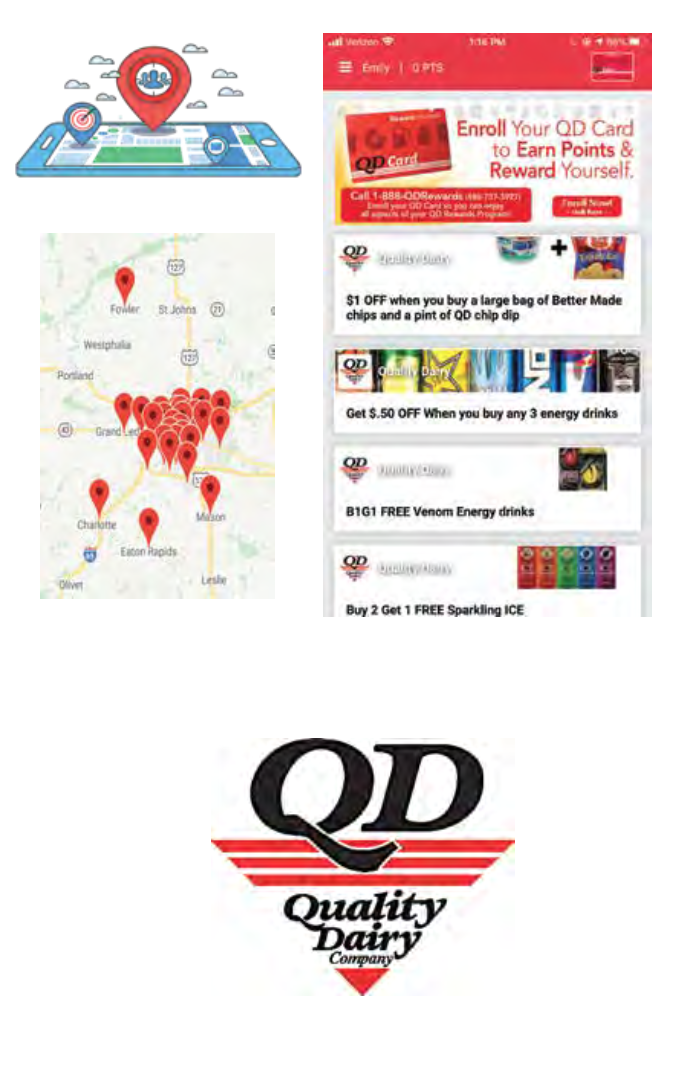 Established in 1936, Quality Dairy Company (QD) began as a local milk store, breaking away from at-home milk delivery. Over the past 84 years, QD has grown into a family-owned convenience store chain in the Greater Lansing Area. Aside from providing retail convenience, a variety of the 29 store locations are equipped with gas stations, laundromats, and quick service restaurants.
Established in 1936, Quality Dairy Company (QD) began as a local milk store, breaking away from at-home milk delivery. Over the past 84 years, QD has grown into a family-owned convenience store chain in the Greater Lansing Area. Aside from providing retail convenience, a variety of the 29 store locations are equipped with gas stations, laundromats, and quick service restaurants.
QD’s customer base has shrunk over the years due to changing customer trends, increased competition, and traditional business practices. Because of this, QD is seeking help to increase customer attraction and retention, reduce marketing and promotional costs, and increase company revenues, all while leveraging the technological abilities of the company.
Although located in a centralized region, QD stores can be broken down into several store location types: Lansing City, suburban, rural, and university. A focus of our project is to establish a criteria of influences on consumer buying behavior and determine a process to define customer demographics by each store type.
Another focus of the project is to construct an approach to attract and increase a more diverse customer base. QD has the opportunity to expand and adjust current customer attraction and retention techniques to best serve all potential consumers.
The last focus of the project is to recommend how to best utilize location- specific promotions and geo-fencing. The world of technology is constantly changing and, in order to stay relevant and competitive, QD must come up to date with these advancements.
In order to tackle the deliverables of the project, ample data regarding customer demographics, industry trends, and convenience store best practices must be gathered and analyzed.
Upon completion, Quality Dairy will be left with an improved understanding of the communities in which they operate along with a criteria, process, and recommendations as to how to best attract and serve the members of these communities.
Ranir: Go Green Packaging
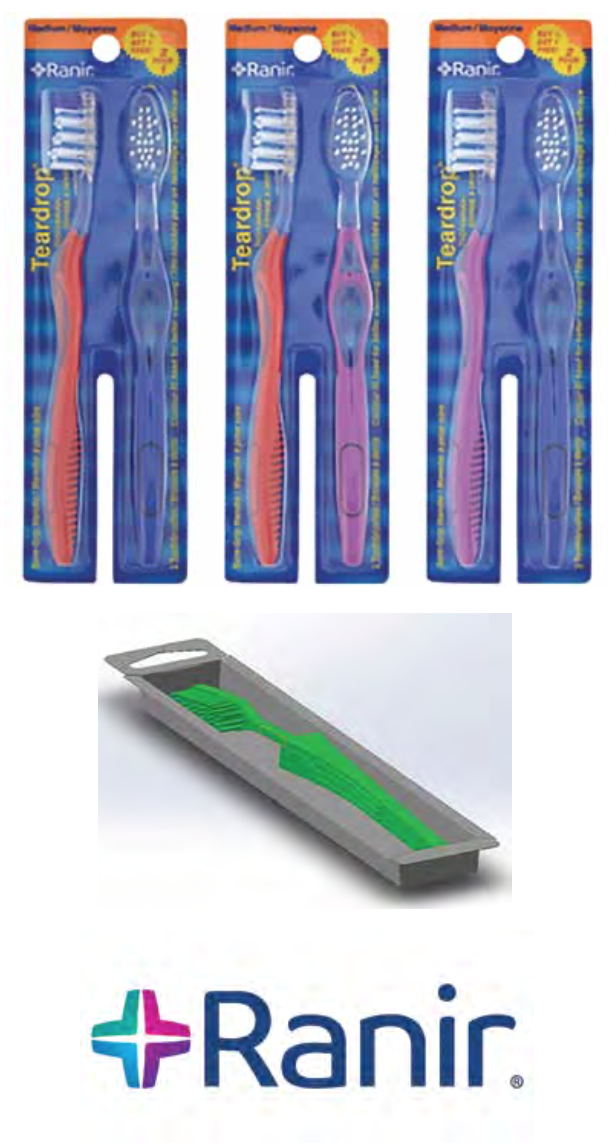 Ranir is a leading global manufacturer of store brand consumer oral care products. They are headquartered in Grand Rapids, Michigan. Ranir’s mission is to serve retail customers globally, and they are committed to delivering affordable, healthy smiles to millions of households every day.
Ranir is a leading global manufacturer of store brand consumer oral care products. They are headquartered in Grand Rapids, Michigan. Ranir’s mission is to serve retail customers globally, and they are committed to delivering affordable, healthy smiles to millions of households every day.
The idea of the Go Green Packaging project from Ranir is to redevelop manual toothbrush packaging to be fully recyclable and potentially compostable. Current toothbrush packaging involves a backer made from paperboard and a plastic blister that can fit all of the different manual toothbrush designs manufactured at Ranir. This redesign would eliminate all plastic involved in the package and use a cellulose screen on the backer for visibility of the product.
In addition to the redesign, a cost analysis was performed to compare the current package design costs to the new package design costs. The cost analysis specifically looked into the individual package parts, including the paperboard backer, label and plastic blister, together with machine and labor costs. Cost savings are not required for this project, but they may be achievable through reduced labor as this new process would be more automated. The cost analysis will help determine feasibility and cost efficiency of the new package.
Overall, this project is a great opportunity to assist Ranir in reaching their sustainability goals while our team learns about driving a large project from start to finish.
The team is an interdisciplinary team that is comprised of Applied Engineering Sciences students and Supply Chain Management students. We were able to apply packaging and supply chain knowledge from coursework and internships.
Ingersoll Rand: Long-Term Strategy for Sustainability in Logistics
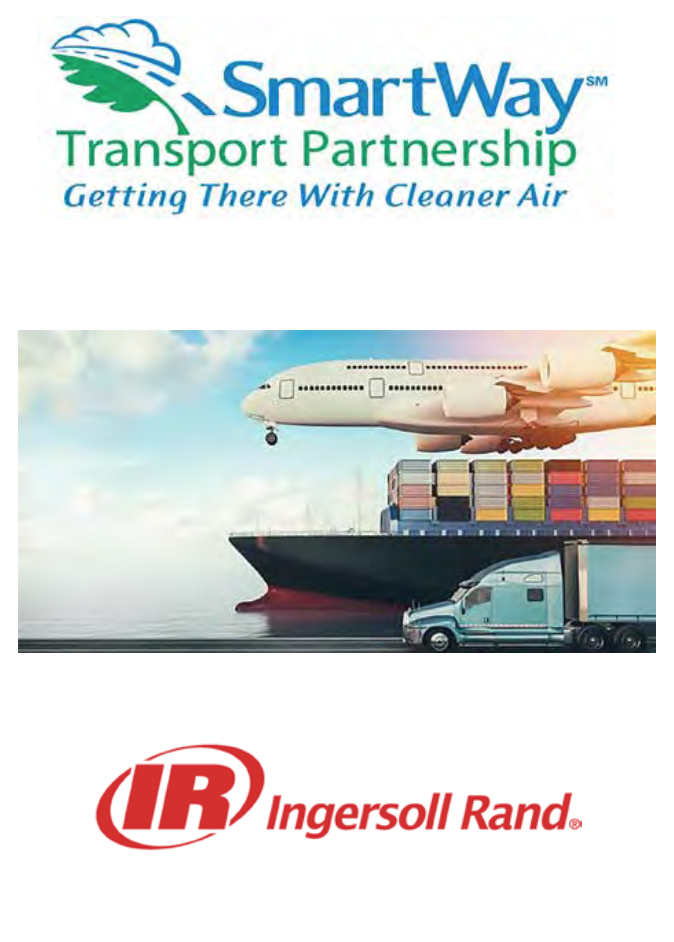 With a history dating back to 1871, Ingersoll Rand is a global industrial manufacturing company that includes market- leading brands, such as Club Car, Trane and Thermo King, that serve customers in commercial, industrial and residential markets. Ingersoll Rand strives to advance the quality of life by helping customers achieve real progress and create a positive impact in their world, while making environments comfortable, sustainable, and efficient.
With a history dating back to 1871, Ingersoll Rand is a global industrial manufacturing company that includes market- leading brands, such as Club Car, Trane and Thermo King, that serve customers in commercial, industrial and residential markets. Ingersoll Rand strives to advance the quality of life by helping customers achieve real progress and create a positive impact in their world, while making environments comfortable, sustainable, and efficient.
As part of the company’s 2030 Sustainability Commitment, Ingersoll Rand is striving to reduce their carbon footprint by 1 billion metric tons of CO2e. This Sustainable Logistics Strategy project aims to contribute to this goal, working to reduce other harmful pollutants by providing a long-term strategy for sustainability in logistics. Currently, Ingersoll Rand’s freight vendors participate in the EPA’s SmartWay program, a system for tracking and documenting information about fuel use and freight emissions across supply chains. This project focuses on using reported SmartWay data to assess past emissions for U.S. transportation carriers and evaluate vendor performance.
Additionally, this Sustainable Logistics Strategy project creates tools to help Ingersoll Rand identify and select more efficient transport modes, equipment, and operational strategies. The project provides the opportunity for Ingersoll Rand to reduce emissions and engage in more sustainable logistics practices to better the environment for its customers and the world.
Ingersoll Rand: Carrier Rationalization and Benchmark
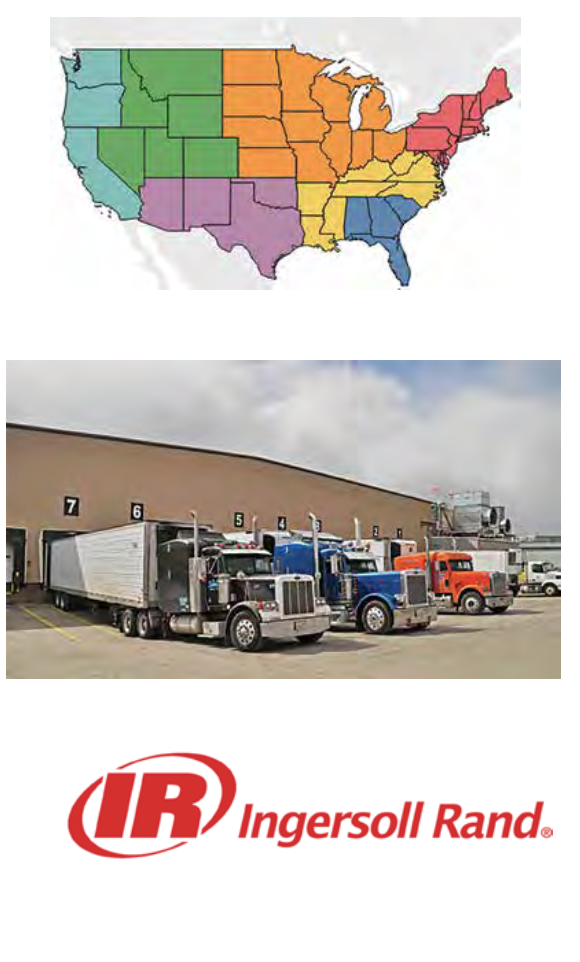 Ingersoll-Rand was founded in 1871 and is a leading diverse industrial conglomerate with over twenty brands in their portfolio. They are well known for reliability, with their best- known brands being Club Car golf carts, Trane air-conditioning systems, Thermo King transport temperature control equipment, and Ingersoll-Rand industrial equipment.
Ingersoll-Rand was founded in 1871 and is a leading diverse industrial conglomerate with over twenty brands in their portfolio. They are well known for reliability, with their best- known brands being Club Car golf carts, Trane air-conditioning systems, Thermo King transport temperature control equipment, and Ingersoll-Rand industrial equipment.
Within North America, Ingersoll-Rand currently spends approximately $275 million a year in transportation costs associated with Truckload, Less-Than-Truckload, and third-party shipping transportation modes. They currently utilize hundreds of carriers within their carrier portfolio with a mix of asset-based, broker, and dedicated carriers.
Our team has developed a Carrier Portfolio Breakdown Dashboard that provides a user-friendly interface that visualizes and rationalizes the current carrier portfolio within Ingersoll-Rand. It allows the user to visualize what transportation type is taking place and by which carriers within each custom defined region in North America. Additionally, this dashboard allows users to easily see cost, weight, and mileage data.
The transportation types that can be filtered are inbound vs outbound, truckload vs less-than-truckload vs third-party shipping, and asset-based vs broker vs dedicated.
This dashboard also offers predictive analytics and allows users to see what would happen nationally and within each region if a carrier or carrier type were changed.
In addition to predictive analytics, this dashboard performs internal benchmarking of the current carrier mix, grading each carrier based on performance data, while also recommending which carriers should be used less or eliminated and which carriers should be utilized more.
Ingersoll Rand: Fusing Transportation Costs into Material Planning
 Ingersoll Rand is a diversified industrial manufacturing company committed to its mission of inspiring progress. With headquarters in Dublin, Ireland, Ingersoll Rand currently has more than 99 manufacturing facilities worldwide. Ingersoll Rand works to improve productivity through innovative equipment, products and services that extend through global commercial, industrial and residential markets.
Ingersoll Rand is a diversified industrial manufacturing company committed to its mission of inspiring progress. With headquarters in Dublin, Ireland, Ingersoll Rand currently has more than 99 manufacturing facilities worldwide. Ingersoll Rand works to improve productivity through innovative equipment, products and services that extend through global commercial, industrial and residential markets.
The focus of the project is on a facility located in Lynn Haven, Florida that produces commercial grade Heating, Ventilation and Air Conditioning (HVAC) units to customers throughout the United States. Currently, there are issues with shipments being received and sent out that are not being used for their fullest potential loads, causing high and unnecessary transportation costs. The Lynn Haven Facility exclusively uses third-party companies which primarily include Flatbed shipments having direct point-to-point routes and Less-Than-Truckloads (LTLs) shipments that require multiple stops and additional points of contact before reaching the desired destination. It is within these two shipment types that there is room to reduce the mileage of both inbound and outbound shipments in addition to reducing emissions.
Our team project is to look at one of Ingersoll Rand facility’s inbound and outbound transportation shipments to see if there is room for route optimization in addition to total cost minimization. Through consolidating shipments going to/coming from nearby locations, total mileage across the shipments will be reduced, decreasing the overall emission levels of the shipments, thus optimizing the current transportation network. Simulations were used to look at various route options, such as milk runs, cross-docks, and a hybrid of the two, to give Ingersoll Rand numerous options to best minimize their transportation costs and emissions.
ASU/NASA Psyche Mission: Art and STEM Vision for Future Interns
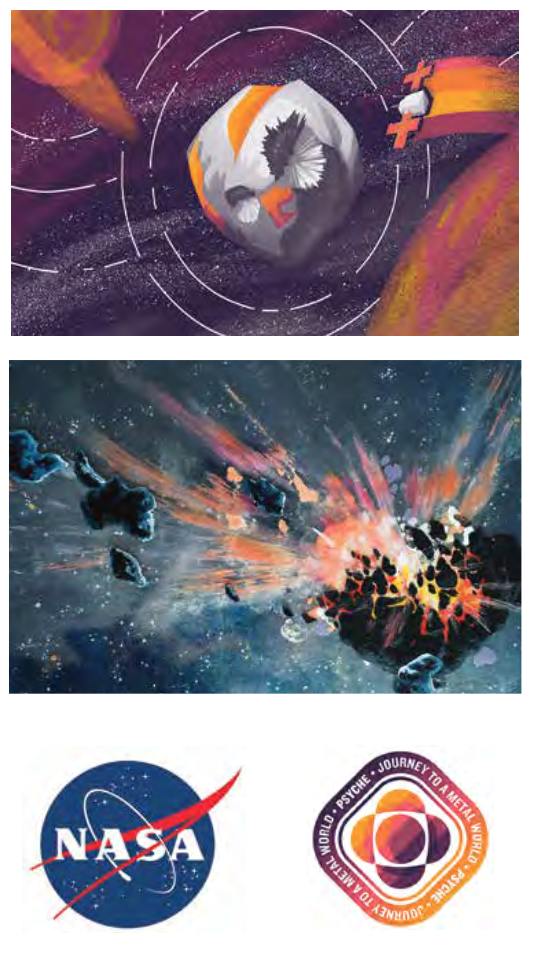
It all started with one woman, one team, and one vision. Lindy Elkins- Tanton is the principal investigator of NASA’s mission to a metal asteroid named 16 Psyche. The mission seeks to determine whether this asteroid, located between Jupiter and Mars, is the metallic core of an early protoplanet. Launching in 2022, the findings of this mission will provide insight into not only the asteroid, but also our Earth. Psyche Inspired is an internship program that brings undergraduate students from any university, discipline, or major together. The program’s goal is to share the excitement, innovation, scientific, and engineering content of NASA’s Psyche mission with the public in new ways through artistic and creative works.
Our project is to better understand how to administer the program to provide maximum impact for the interns, their universities and communities, and the public. Meetings were held with our NASA sponsor to determine the direction we should take when establishing the scope of our project. Surveys were created and sent to past and current interns to gain insight into what changes need to be made to improve their experience while taking into consideration the requirements held by Psyche Inspired.
The resulting project encompasses the intern experience and the administration of the program, separating the interns into two directions: one focusing on outreach and the other on STEM concept illustration. Themes were designated to each group that help emphasize and inspire Psyche interns. To help intern outreach, themes including some of NASA’s core values, will be used to inspire viewers about the mission. Students working under the STEM concept illustration are given resources to develop creative works centered around the science, technology, engineering, and mathematics that go into the space mission. Our systemic and process improvements to the National Art and STEM Program will help future Psyche interns and administrations thrive.
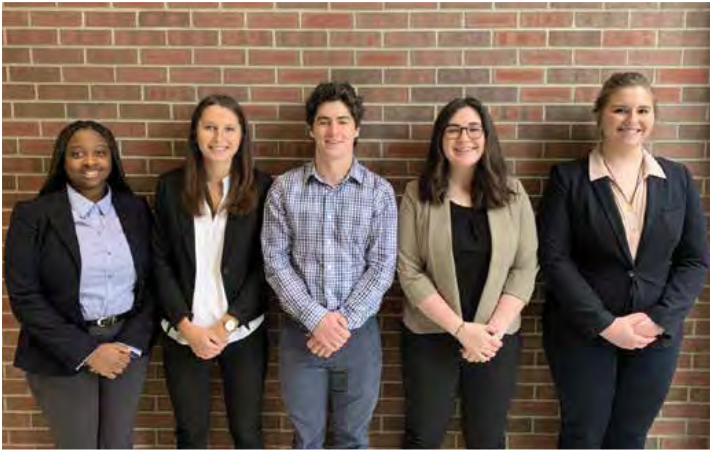
Team Members (L-R): Fadzai Joy Mazhangara, Kelly Littmann, Jackson Reetz, Julia Gabrysh, Miya Vantol
BP PLC: Effective Usage of Producer Price Indexation Analysis
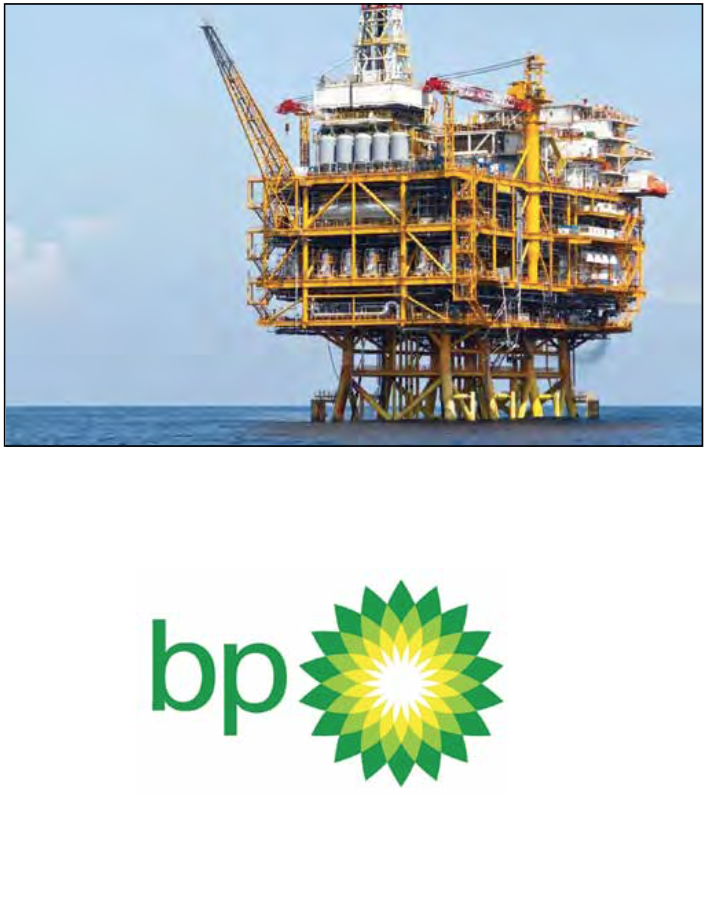 BP PLC has a strategy of best operator in the Gulf of Mexico. A key element is cost competitiveness. Effective use of Producer Price Index (PPI) values would support BP in business forecasting, deciding when to approach markets for price negotiations, use strategic levers to mitigate anticipated cost increases or take advantage of decreases, and understanding underlying factors in the oil field service market.
BP PLC has a strategy of best operator in the Gulf of Mexico. A key element is cost competitiveness. Effective use of Producer Price Index (PPI) values would support BP in business forecasting, deciding when to approach markets for price negotiations, use strategic levers to mitigate anticipated cost increases or take advantage of decreases, and understanding underlying factors in the oil field service market.
Using internal indexation and commodity weight distributions, a model can be created for two of BP’s offshore rig components: drilling and completions. The PPI data points are public values provided by the U.S. Bureau of Labor Statistics measuring the average change over time in the selling prices received by domestic producers for their output.
The overarching goals and opportunities of this project align with the project deliverables. First, having a clear understanding about the oil and gas industry/services will provide insight into market trends and clarify empirical relations within the field based on well services and pricing. Second, using computational data and updated PPI values over the past five years, opportunities for BP to improve their existing negotiation strategy from conviction to data driven decision-making will present itself. Last, in relation to the first two goals and opportunities, they will ensure that BP has a reconditioned negotiation model that allows for cost competitiveness using strategic levers to reallocate spend according to the updated and validated commodity weightings.
In accordance with the above deliverables BP will be equipped with a tool to improve their negotiation process allowing them to directly correlate the PPI values with their commodity weightings.
BP PLC: Subsea Hardware Inventory Management Optimization
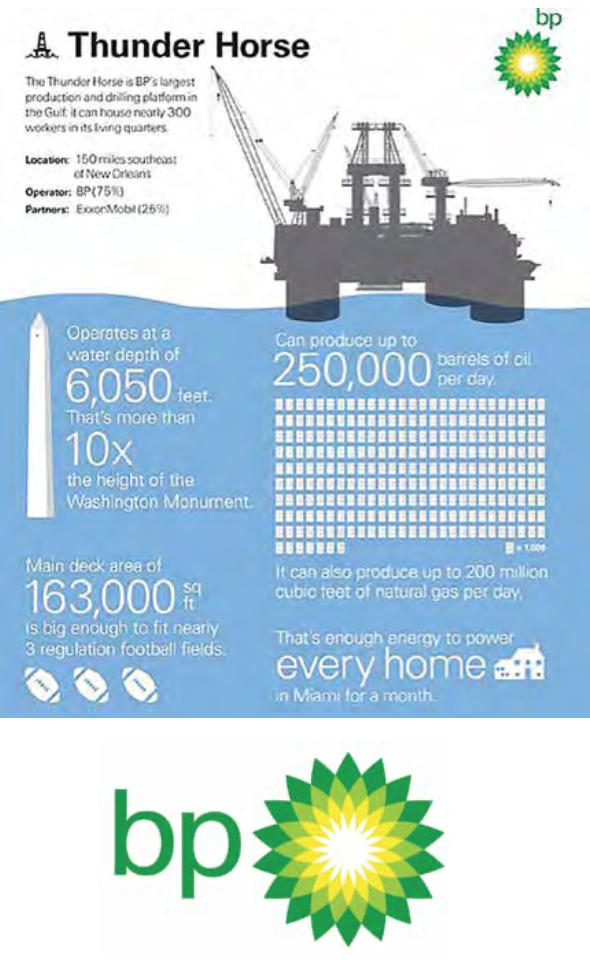 For over a century, BP PLC has been one of the leading oil and gas companies in the industry. BP has assets all over the world ranging from the desert to the ocean. The focus location for this project is concentrated in the Gulf of Mexico.
For over a century, BP PLC has been one of the leading oil and gas companies in the industry. BP has assets all over the world ranging from the desert to the ocean. The focus location for this project is concentrated in the Gulf of Mexico.
The Gulf of Mexico holds some of the largest oil reserves in the world, making it a very profitable region for the oil industry. With that, it can be difficult to forecast how much inventory a company actually needs to effectively operate an oil rig. This is an issue BP is currently grappling with in the Gulf of Mexico.
Specifically, BP is experiencing a surplus of subsea hardware to run the four oil rigs they operate with multiple partners in the Gulf. This specific hardware is used to run and maintain the everyday operation on each of these oil rigs. The size of equipment ranges from small pieces, which can be purchased with a short lead time, to large pieces that take over a year to receive and utilize. These variable lead times make forecasting extremely difficult when it comes to ordering such hardware.
Our team has been developing different tools and recommendations that BP can use to monitor, analyze, and forecast equipment inventory levels. The main objective is to recommend what BP should do with their excess inventory holding cost, as well as to recommend a way to prevent this issue from occurring in the future.

Team Members (L-R): Jeff Ingell, Xinchen Hu, Justin Spindler, Glen Kastelic, Jiawei Wang
BP PLC: Contract Management in Procurement and Supply Chain
 Headquartered in London, England, BP PLC is a multinational oil and gas company. The firm operates in 78 countries worldwide and has approximately 73,000 employees.
Headquartered in London, England, BP PLC is a multinational oil and gas company. The firm operates in 78 countries worldwide and has approximately 73,000 employees.
This global reach has allowed BP to maintain a diverse portfolio of businesses including upstream, downstream and alternative energy businesses, as well as many other things. Specifically, within BP’s Upstream Business, there are multiple core/strategic suppliers who have multiple contracts in place to cover the work being executed globally. BP uses Global Frame Agreements (GFAs) that outline specific terms and conditions that BP and their suppliers have agreed to, reference and follow for work orders.
Subsea is the target market for this project. The subsea market recently has undergone significant changes and there is a push to find another way to manage these contracts currently operated in silos between procurement and engineering. This Contract Management project provides the opportunity to help BP reduce contractual cycle time, reduce risk, and costs through a Total Expenditure Model of developing offshore projects and consolidating projects. This provides the key to enable BP to achieve highest efficiency when working with their suppliers of the subsea market. There are four main questions from BP that our team needs to answer. What are the cost savings for BP and suppliers? What is the total cost of implementation? What challenges will BP face when implementing the recommendation? How will BP mitigate the potential risks associated with the recommendation?
All of these questions will be answered using a TOTEX model to show the data.
American Axle and Manufacturing: Shim Project – A Required Parts Forecast Model
 American Axle and Manufacturing is a manufacturer of automobile driveline and drivetrain components and systems. AAM is headquartered in Detroit, Michigan and has locations all over the world.
American Axle and Manufacturing is a manufacturer of automobile driveline and drivetrain components and systems. AAM is headquartered in Detroit, Michigan and has locations all over the world.
Shims are a small, but important part in AAM’s manufacturing process. A shim is a washer or small piece of material that is used to align parts, make them fit, or reduce wear. Each of AAM’s products has a shim chart that may consist of twenty to thirty different shim sizes. Currently, there is not a process in place that is able to make accurate shim forecasts by part numbers. This has resulted in excess shim inventory in plants, stock-outs, and labor hours wasted on a misaligned shim supply.
Our team was tasked to analyze future customer predicted demand data and historical plant floor usage consumption data to create a forecasting tool that predicts shim forecasts by part number. This tool will be able to notify the supply scheduler at American Axle when there is a significant change in shim demand. This will be accomplished by utilizing Microsoft Excel to create a forecasting tool to accurately predict shim demand. This tool will also be integrated with AAM’s current Enterprise Resource Planning system.
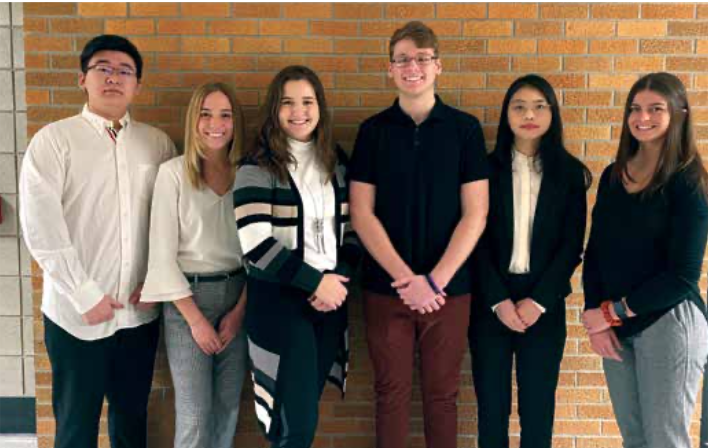
Team Members (L-R): Bosong Wang, Allison Beshears, Chloe Miller, Michael Bucholtz, Junyi Fu, Brianna Zajac
Asahi Kasei Plastics North America: Identify Cost Savings through Spend Data Analysis
 Asahi Kasei Plastics North America (APNA) is a subsidiary of Asahi Kasei Corporation (AKC), a $20 billion Japanese Conglomerate. APNA is known for manufacturing high performance grade polymers for OEMs and tier suppliers around the globe. The materials produced in APNA’s Fowlerville, Michigan and Athens, Alabama manufacturing locations can be found in a variety of areas such as automotive, furniture, industrial, and heavy trucking segments.
Asahi Kasei Plastics North America (APNA) is a subsidiary of Asahi Kasei Corporation (AKC), a $20 billion Japanese Conglomerate. APNA is known for manufacturing high performance grade polymers for OEMs and tier suppliers around the globe. The materials produced in APNA’s Fowlerville, Michigan and Athens, Alabama manufacturing locations can be found in a variety of areas such as automotive, furniture, industrial, and heavy trucking segments.
The focus in North America is to utilize process improvements and efficiencies throughout the various locations. With this in mind, APNA partnered with Michigan State University with a project focused on supplier consolidation and data centralization. This project included working with four other Asahi Kasei subsidiaries located in North America: Sage Automotive Interiors, Celgard, Daramic, and Asahi Kasei Bioprocess.
Our team put together a data analysis and data visibility recommendation after researching the data provided by the five Asahi Kasei subsidiaries. The Python analysis successfully provided detailed recommendations for vendor consolidation within packaging materials at each of the organizations. Additionally, this provided insights to vendor spend across all five subsidiaries allowing Asahi Kasei to take strategic actions to reduce tail spend while eliminating maverick spend.
Another top priority for the five Asahi Kasei subsidiaries was centralized data visibility. The centralized data hub allows North America spend data to be accessible across all five subsidiaries in one location. Consolidating data helps spread best practices and make decisions based on accurate data analysis.
Dow Chemical Company: Integrated Supply Chain Personal Assistant
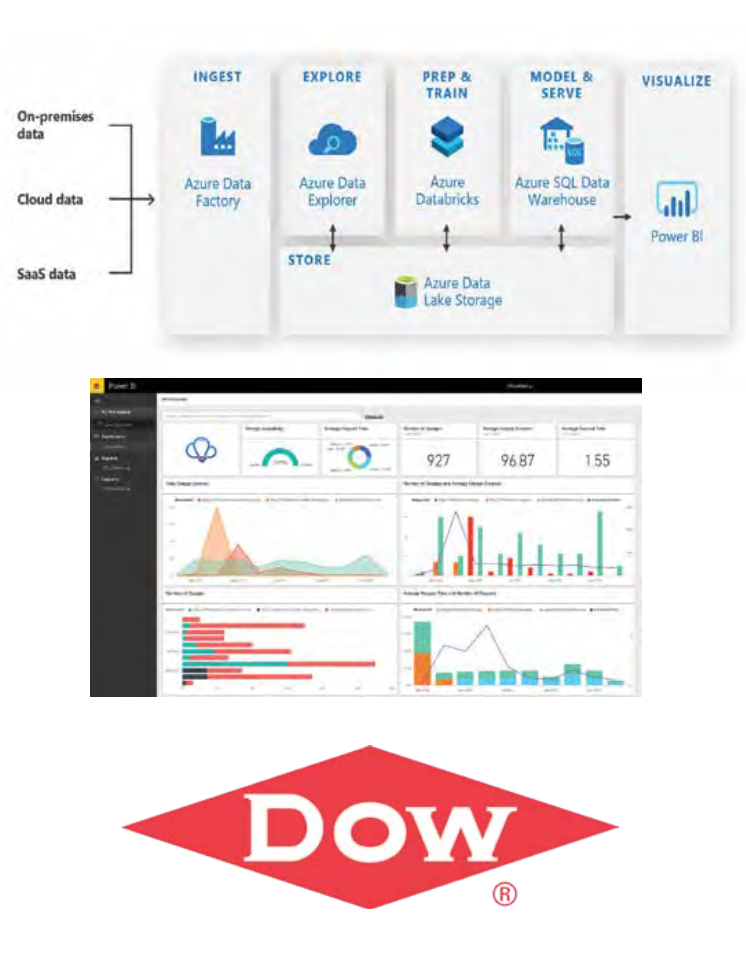 Dow is a multinational company that has a large integrated supply chain and enormous inventory flow among cities and countries. Dow is using Diamond Systems Reporting to facilitate their inventory management. However, Dow’s supply chain analysts are depending on massive Excel sheets to display and extract data manually, which is not efficient for analysts.
Dow is a multinational company that has a large integrated supply chain and enormous inventory flow among cities and countries. Dow is using Diamond Systems Reporting to facilitate their inventory management. However, Dow’s supply chain analysts are depending on massive Excel sheets to display and extract data manually, which is not efficient for analysts.
The current Excel sheets depict cost, volume and price of products offered by Dow in their respective regions. Due to the data being displayed poorly, analysts often cannot accurately predict the data for next quarter. Also, all of the real-time quarterly data need to be entered manually by analysts to make comparisons.
The integrated personal assistant will provide better data visibility by using Power BI to display data on a dashboard. This Power BI dashboard will showcase simple graphs, comparisons to previous quarters, and contain automatic input from the SAP system. An additional function that we will be researching will be a personal assistant. The personal assistant is built on Microsoft Azure and is a QnA bot that would be able to answer questions pertaining to the dashboard. This bot would be able to pull data and perform variable manipulation.
Azure and Power BI have built-in connectivity. This allows the dashboard to pull data effectively from the Dow SAP. The overall goal is to create an adaptive and useful dashboard for the Supply Chain group within Dow that can hopefully be an example for future automated processes.
FreightWaves: Analytics Competition
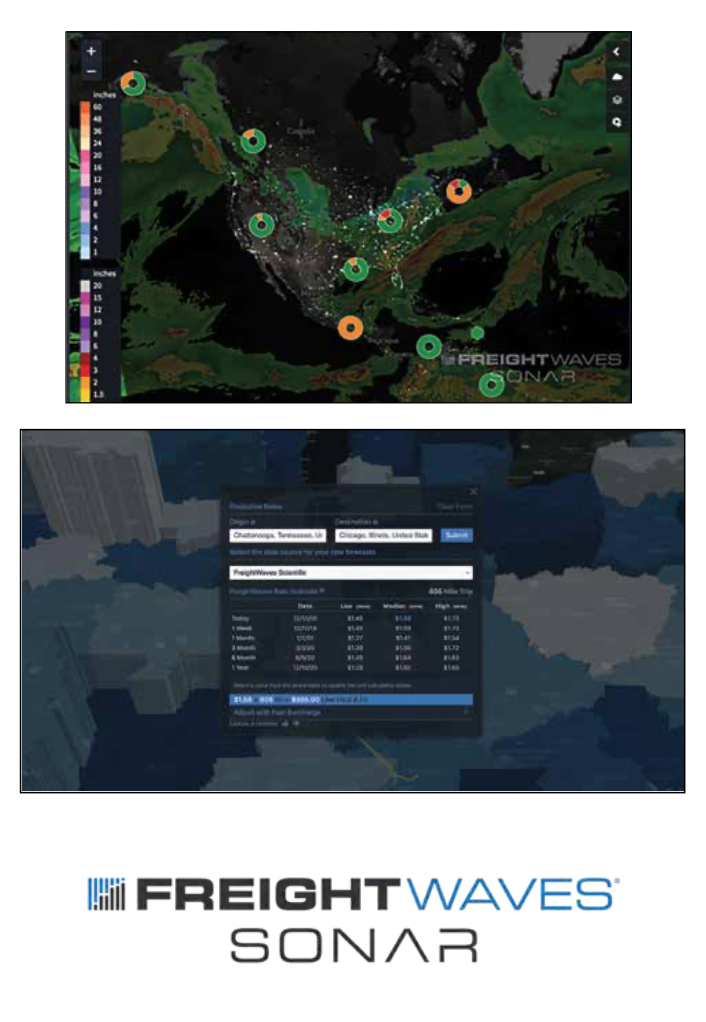 FreightWaves takes pride in being the largest publisher of freight, logistics, cargo and transportation news and data in the world. FreightWaves allows supply chain companies to revolutionize how they make decisions by providing information gathered through their software tool, SONAR. SONAR is an up-to-the-minute information platform that uses the non-stop change in capacity, demand, regulations, weather and more, so that FreightWaves’ customers can successfully respond to market conditions and forecast the future.
FreightWaves takes pride in being the largest publisher of freight, logistics, cargo and transportation news and data in the world. FreightWaves allows supply chain companies to revolutionize how they make decisions by providing information gathered through their software tool, SONAR. SONAR is an up-to-the-minute information platform that uses the non-stop change in capacity, demand, regulations, weather and more, so that FreightWaves’ customers can successfully respond to market conditions and forecast the future.
Our project considers seven transportation lanes: LA to Dallas, Dallas to LA, LA to Seattle, Seattle to LA, Philadelphia to Chicago, Chicago to Atlanta, and Atlanta to Philadelphia. The goal is to deliver insights that outline the most appropriate actions to take in response to market shifts, and present data that support predicting these shifts to assist logistics companies with planning. This will be done by using SONAR to construct visual data (graphs, charts, etc.) representing historical data on multiple influences in the logistics market.
With this data and independent research, our team will deliver insights for forecasting and allow customers and carriers to better plan moving forward, thus making experiences more seamless.


